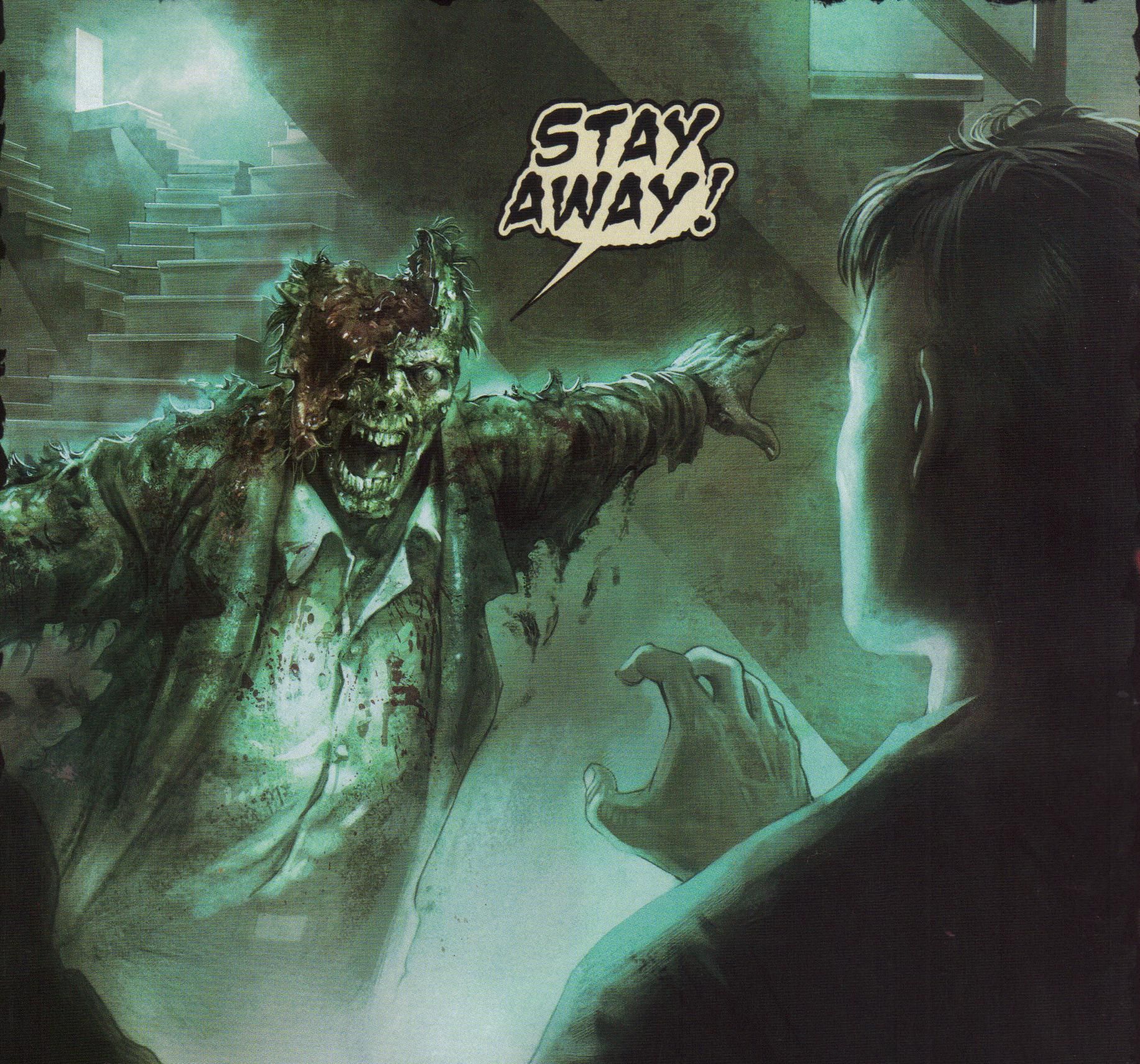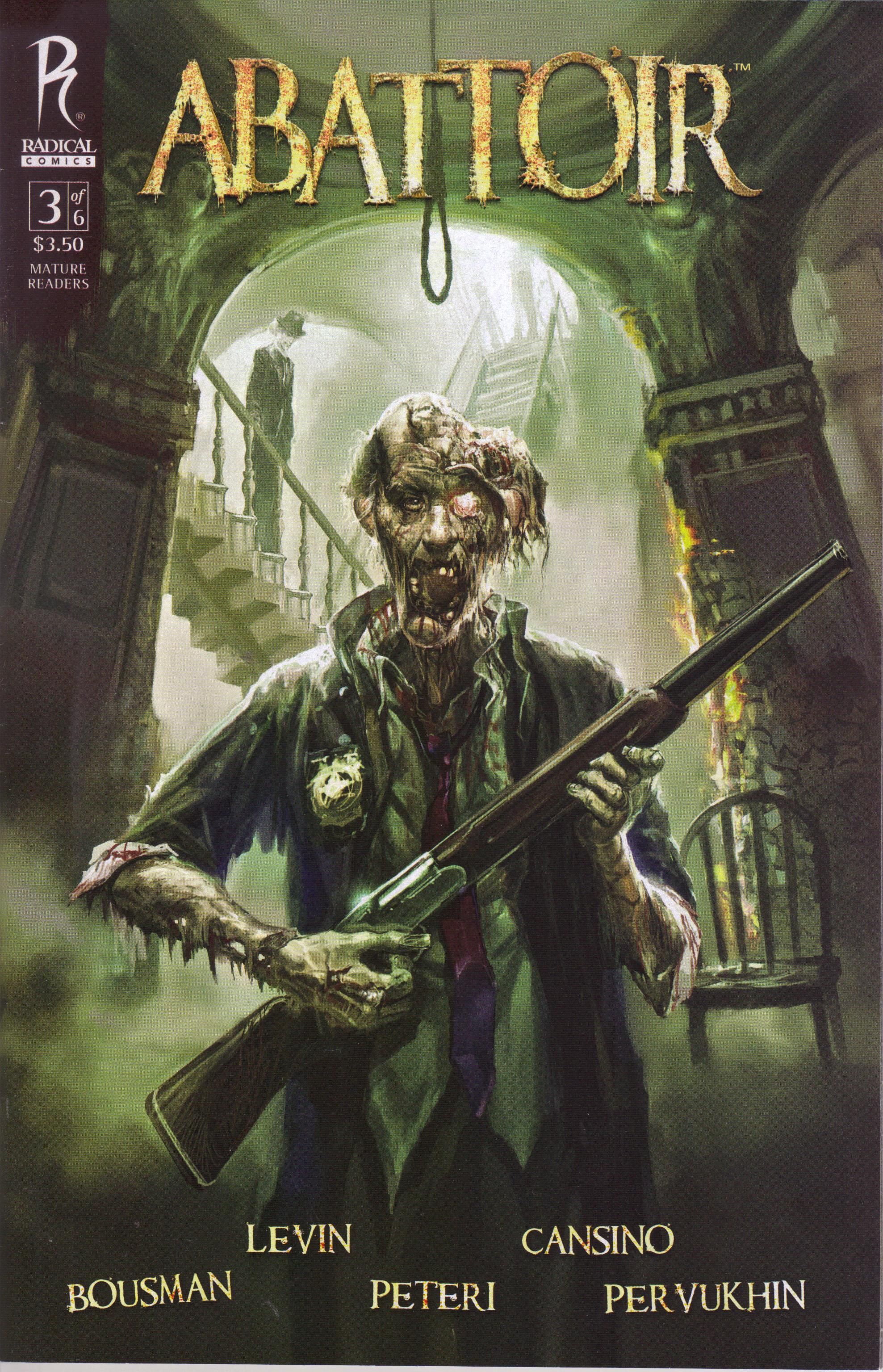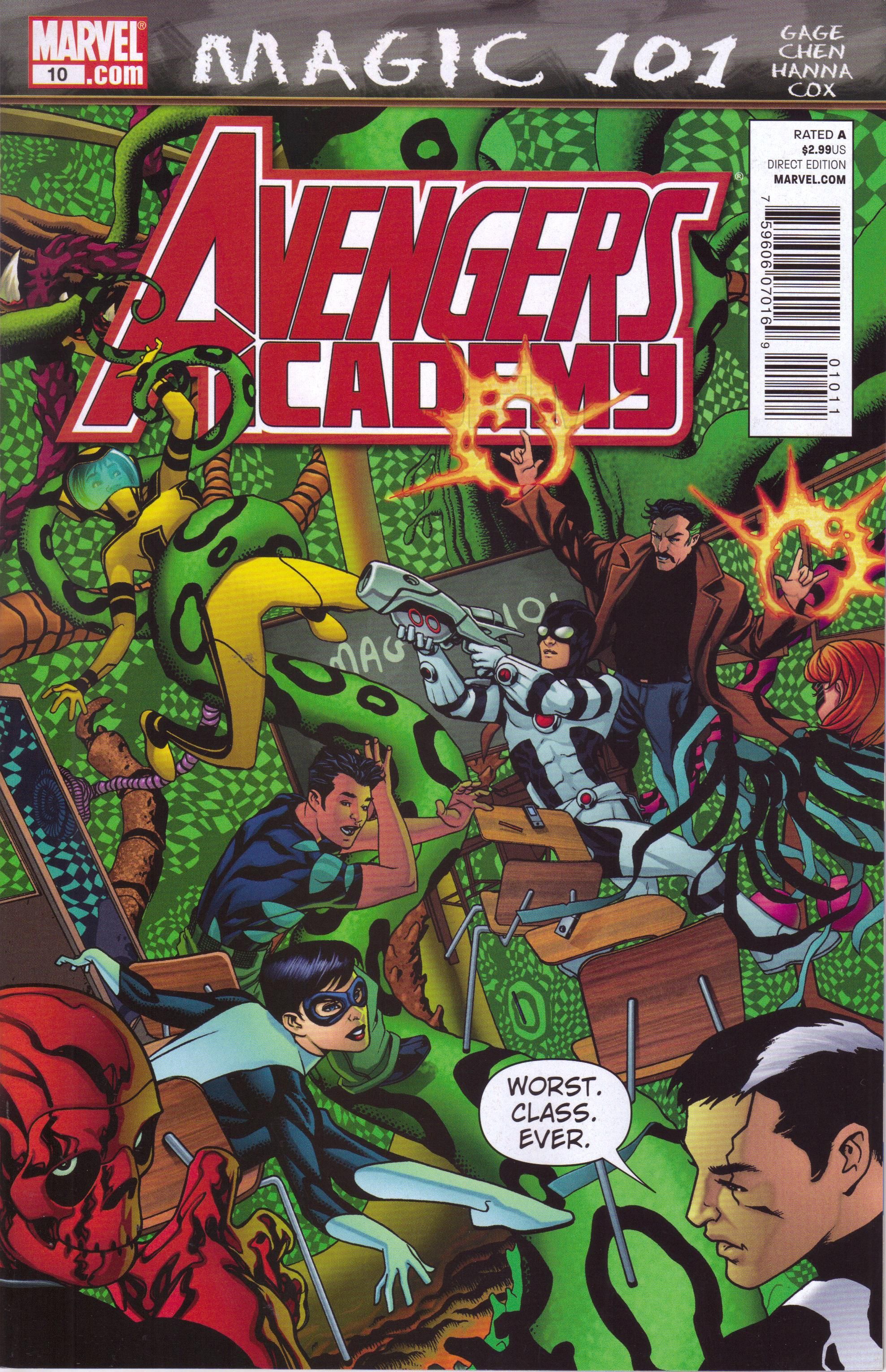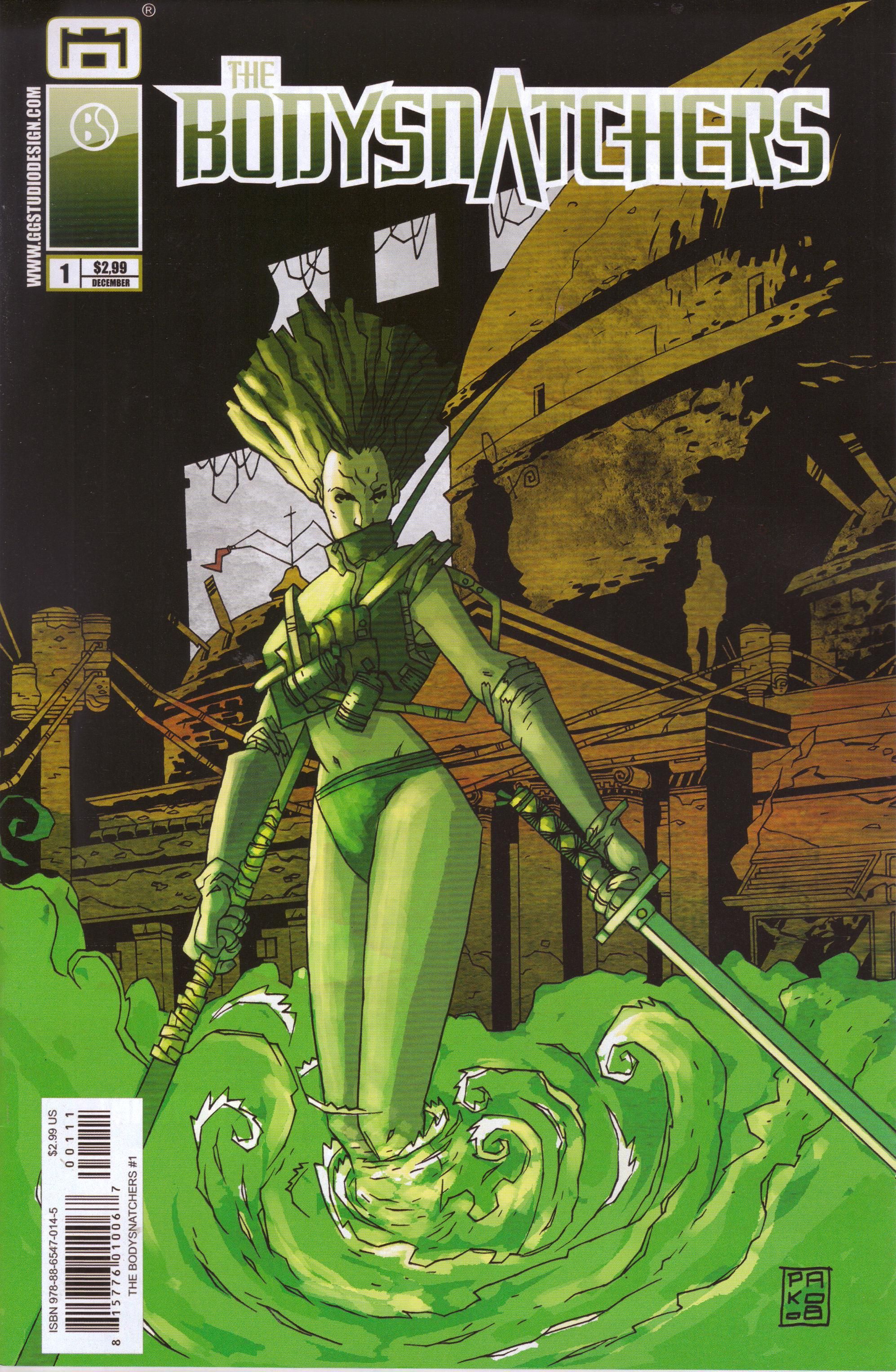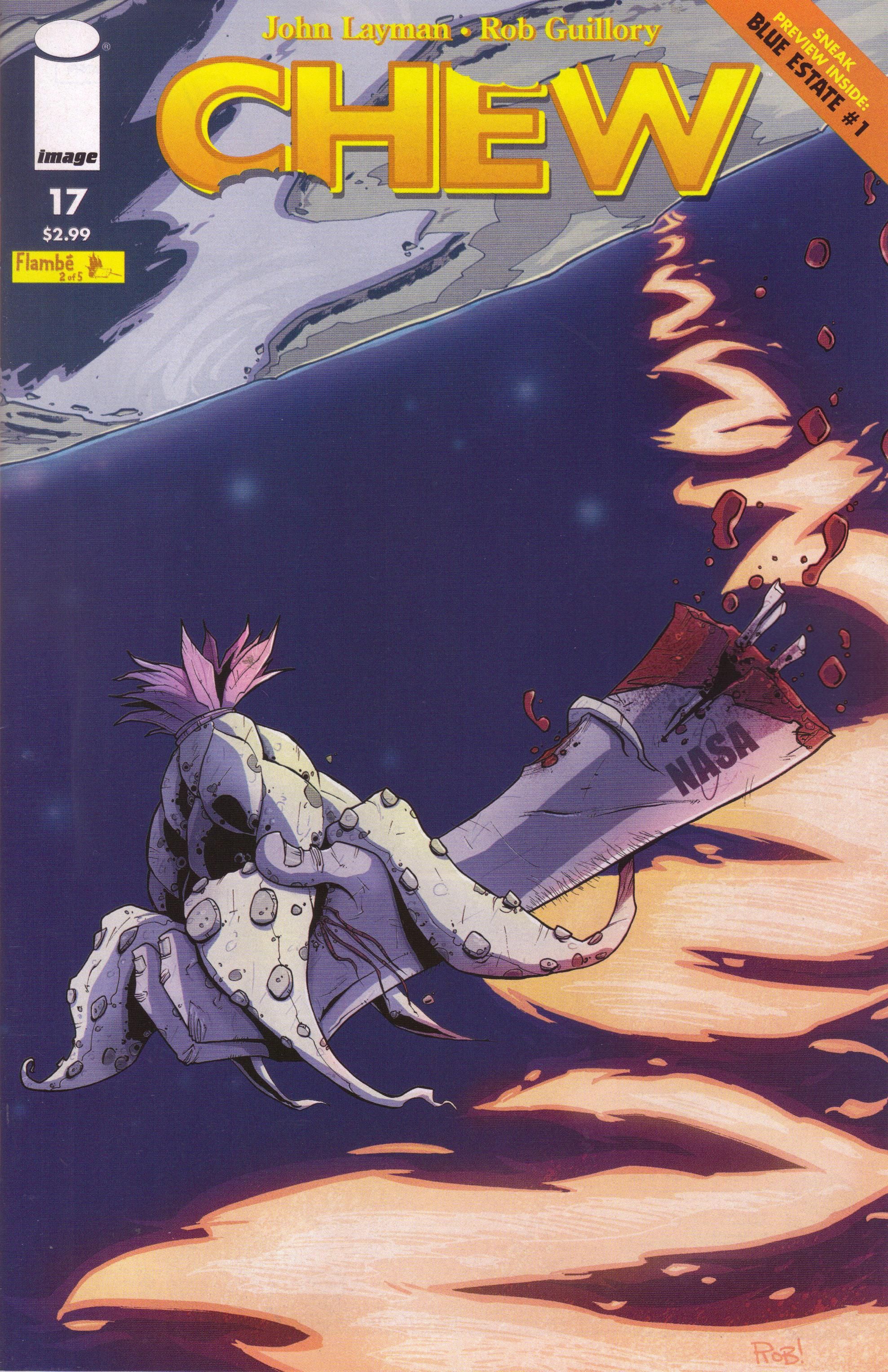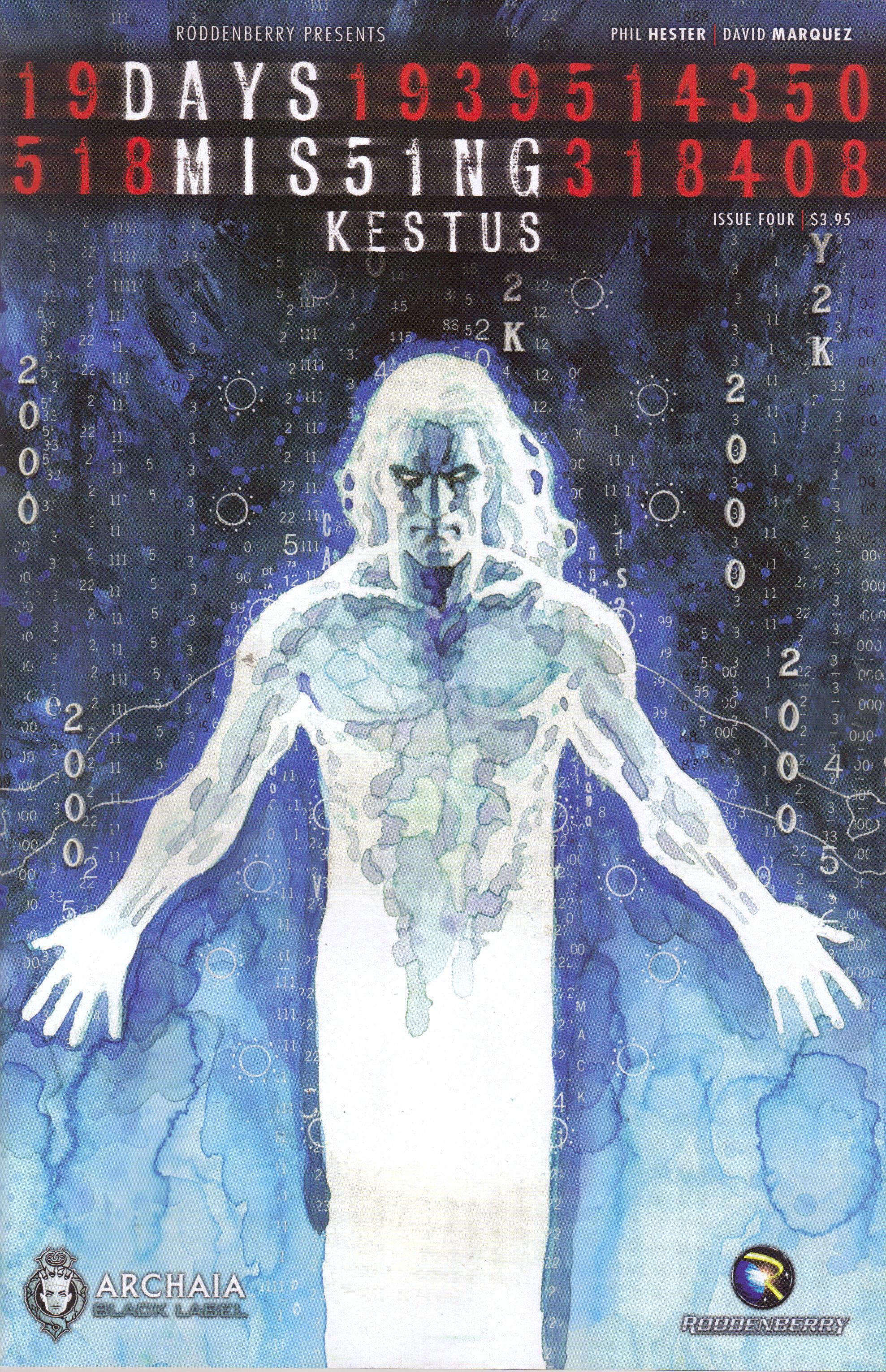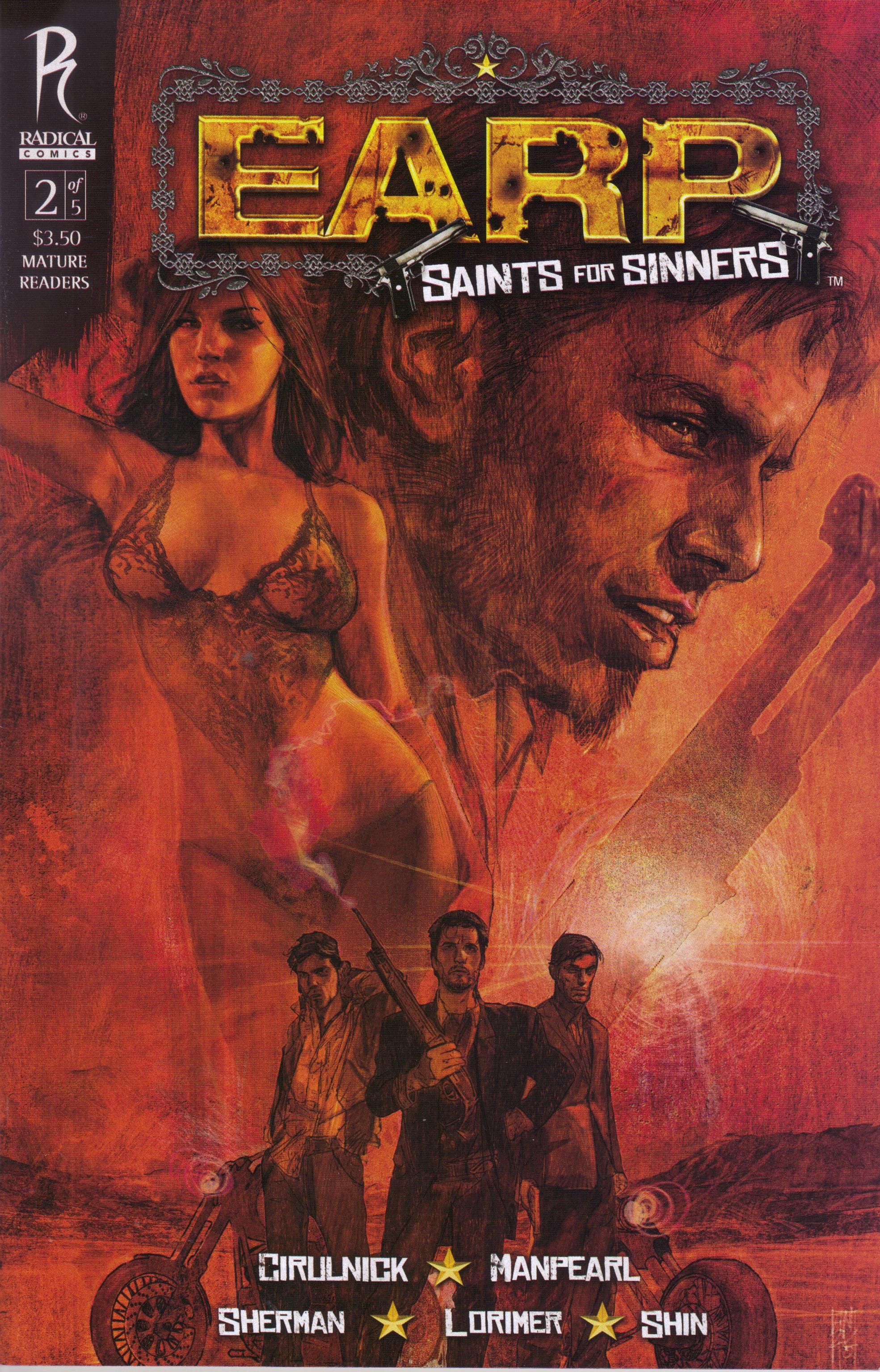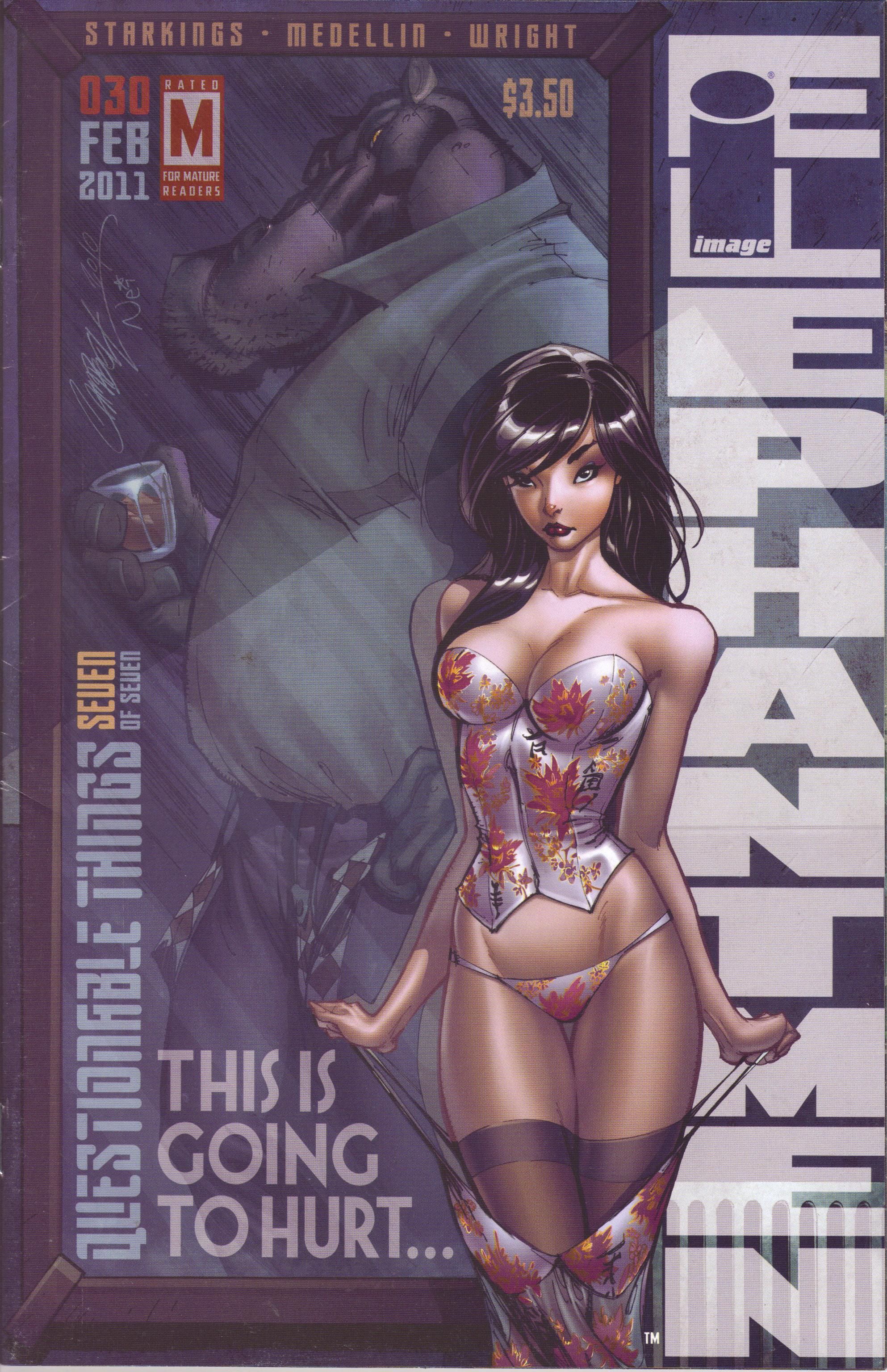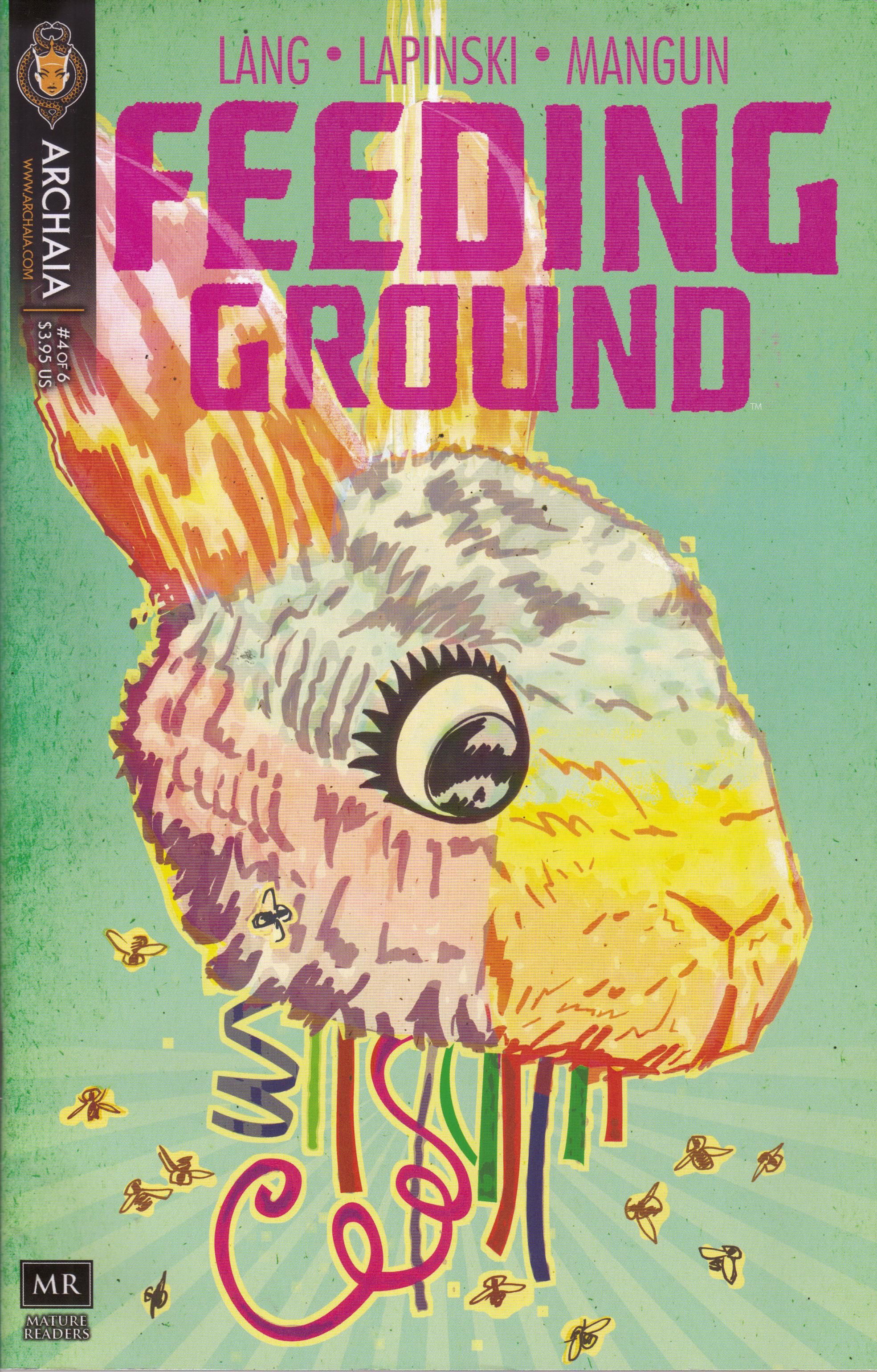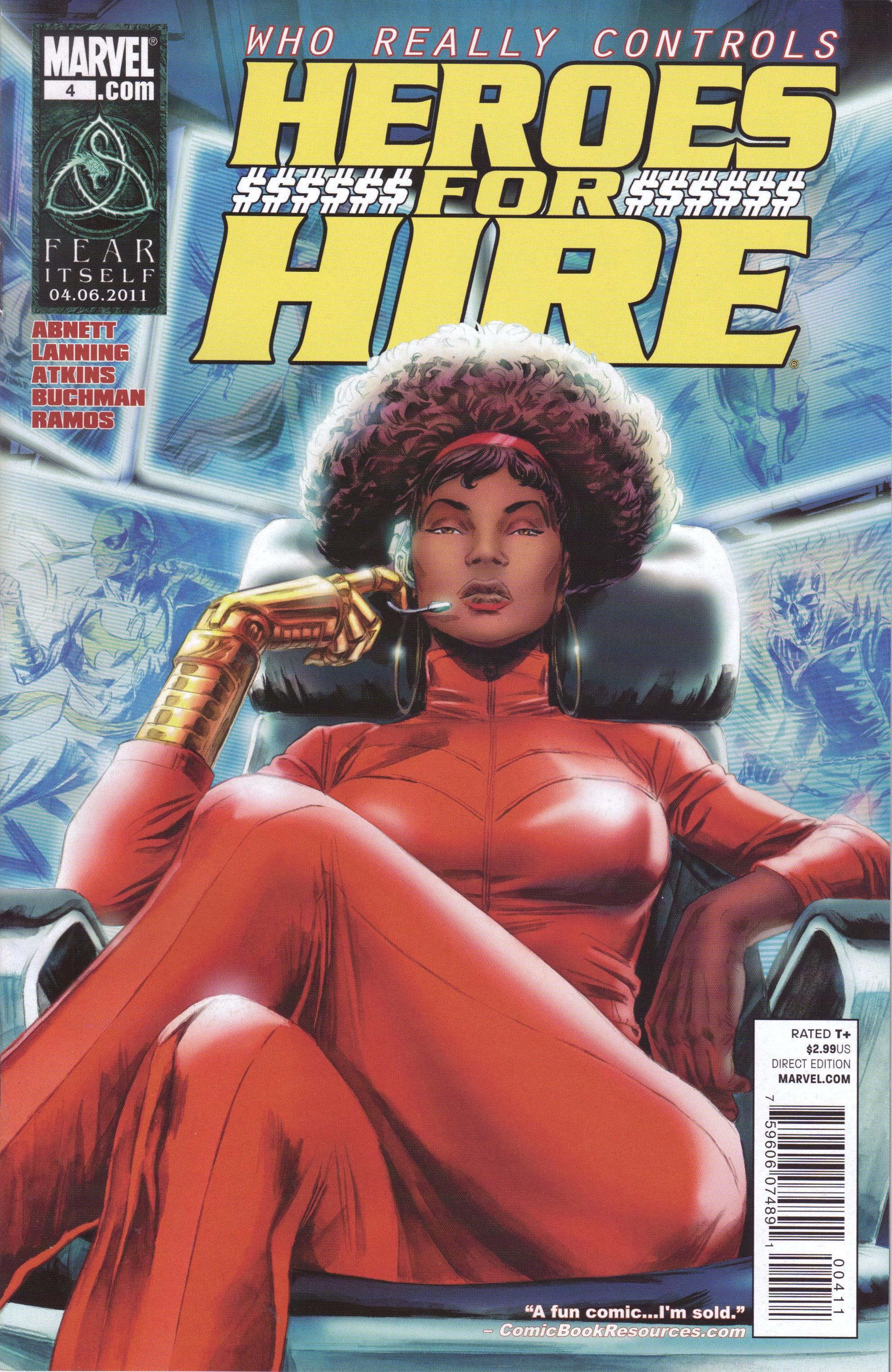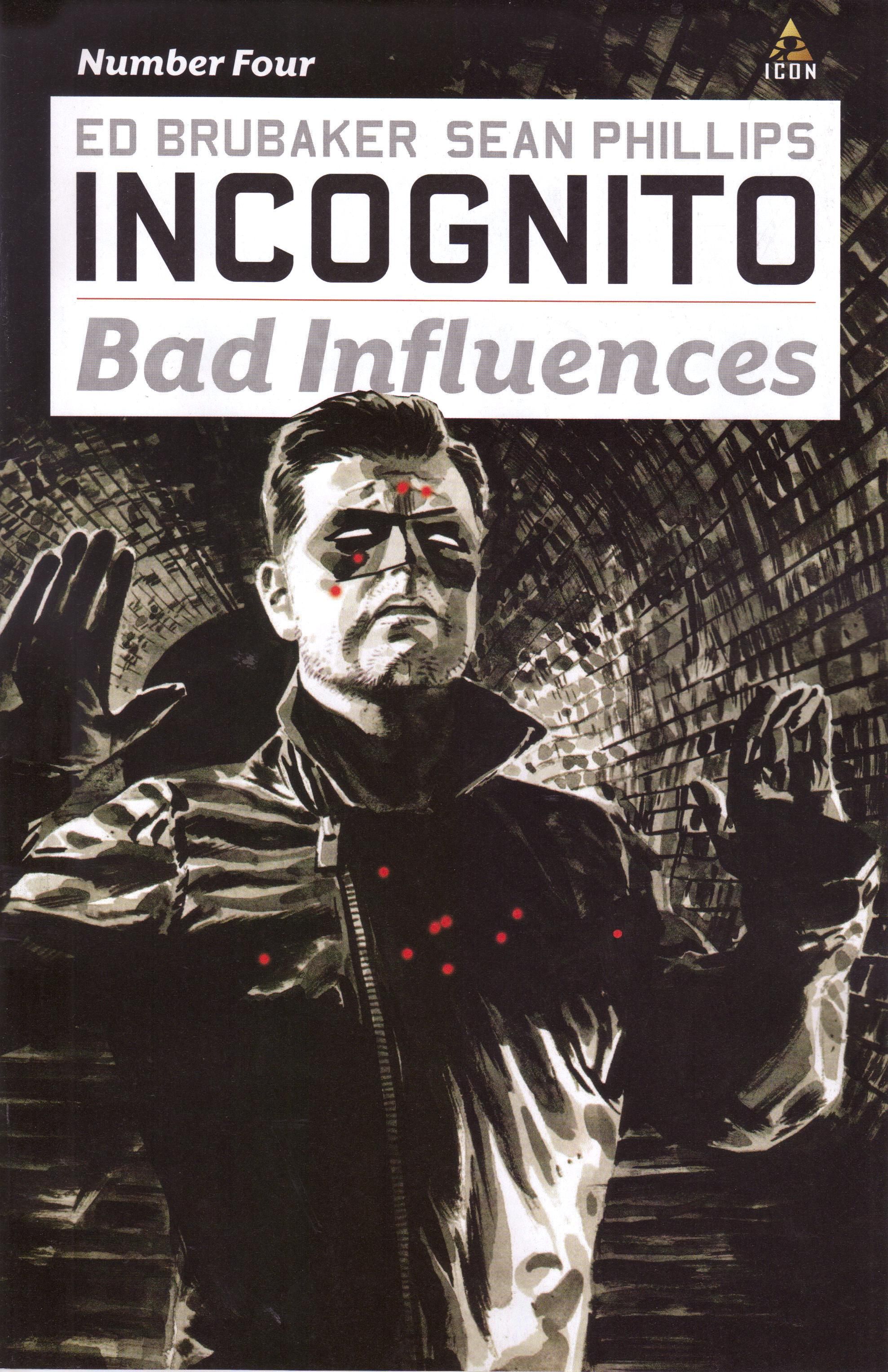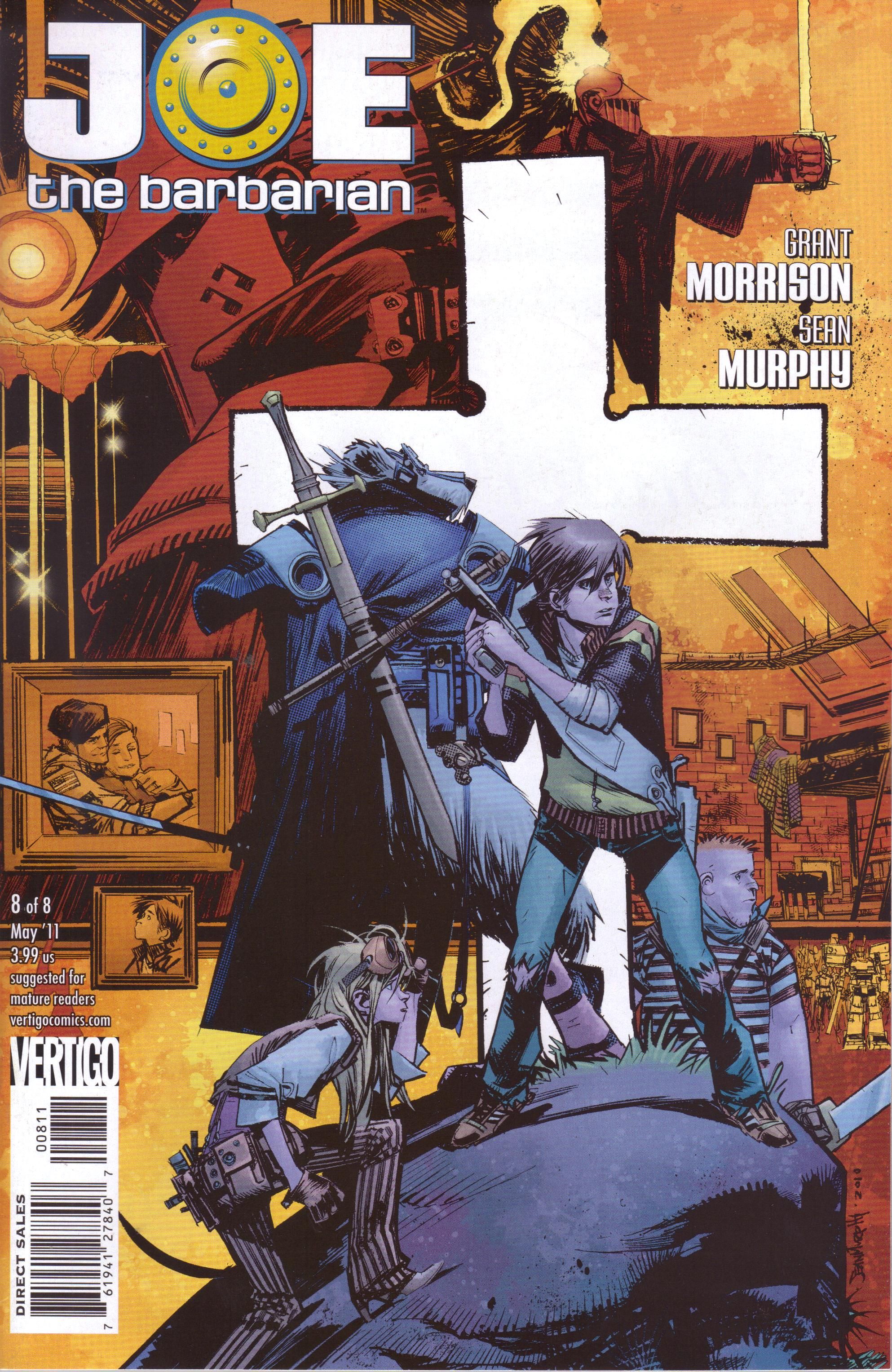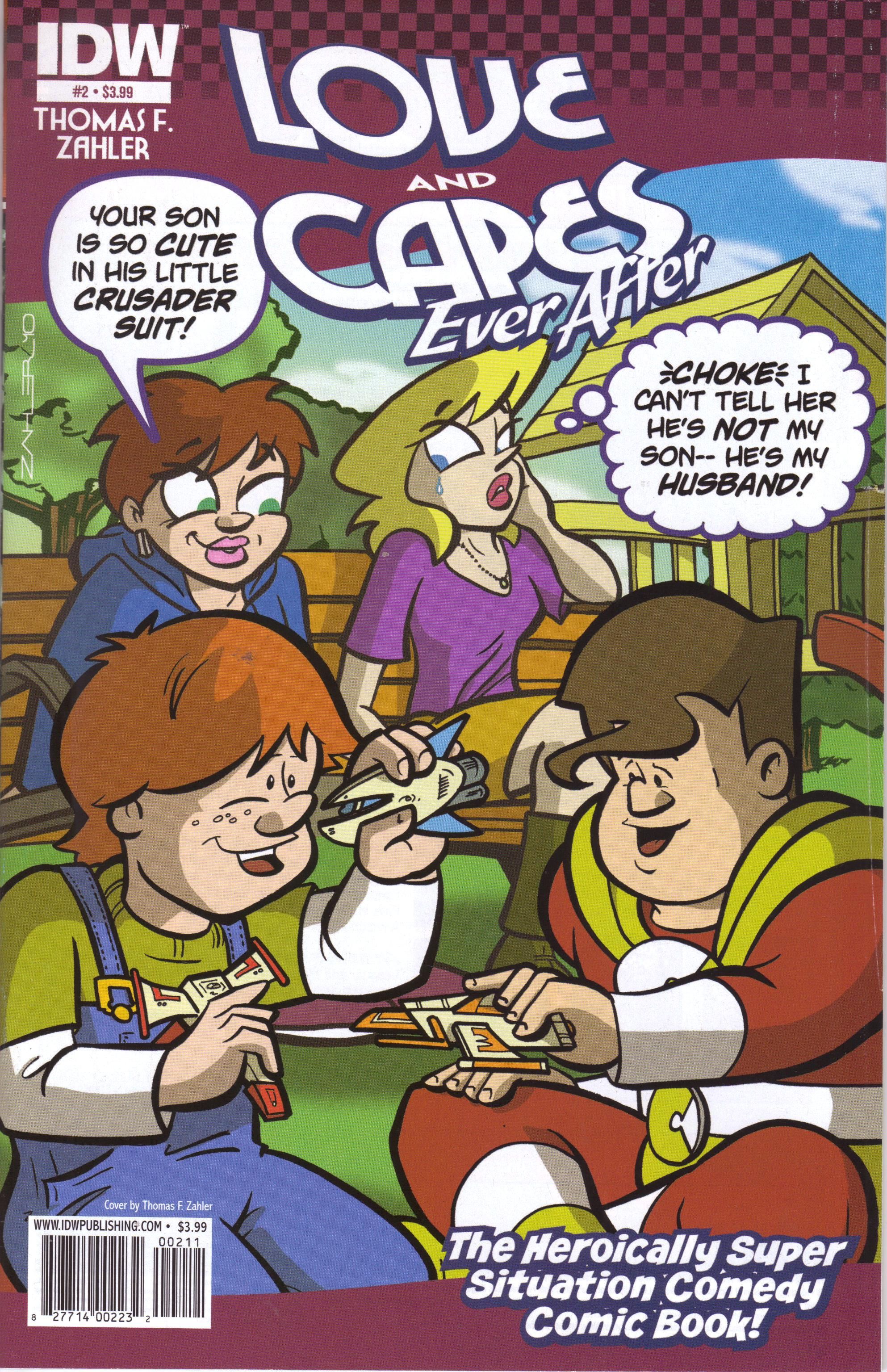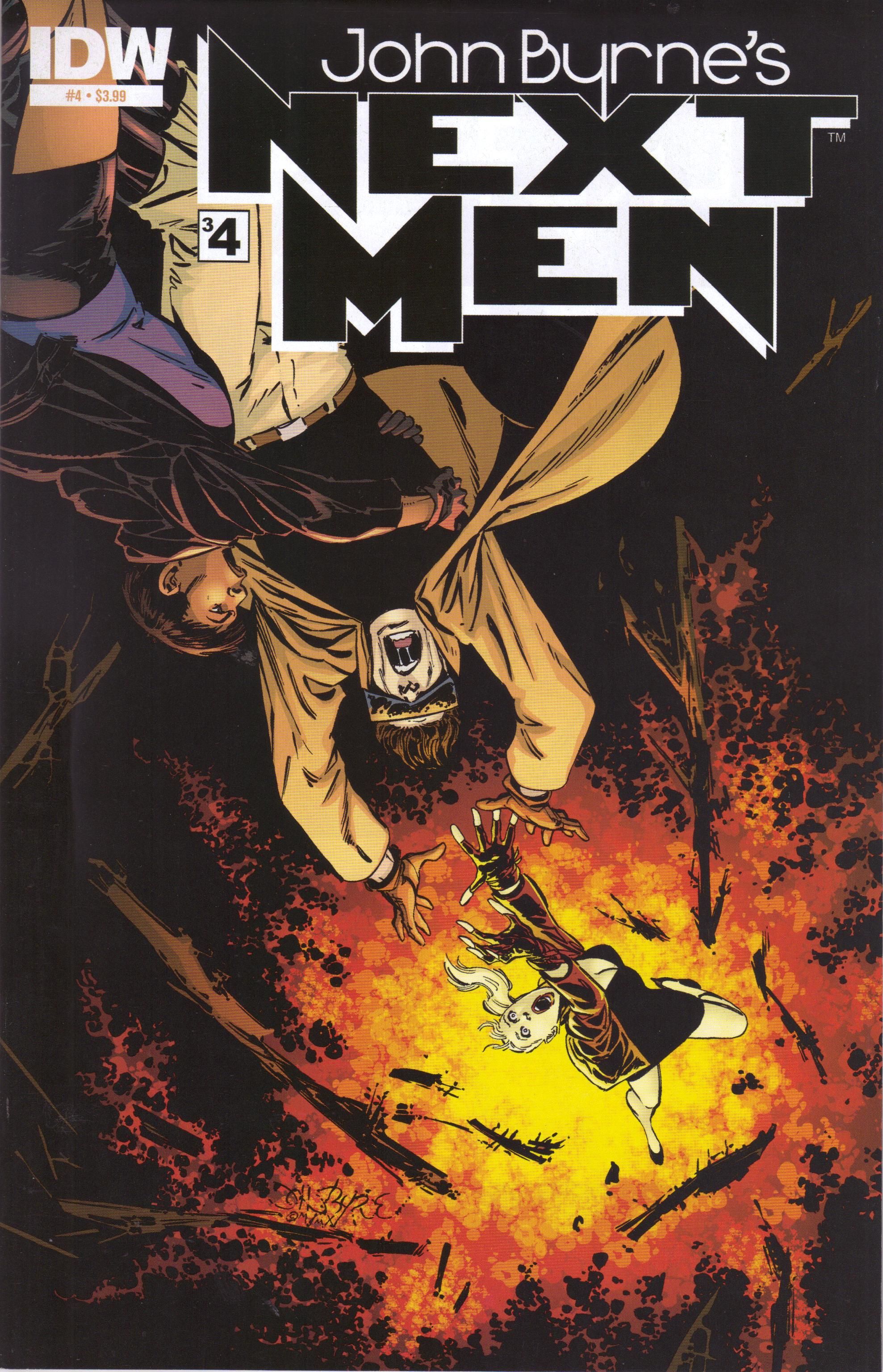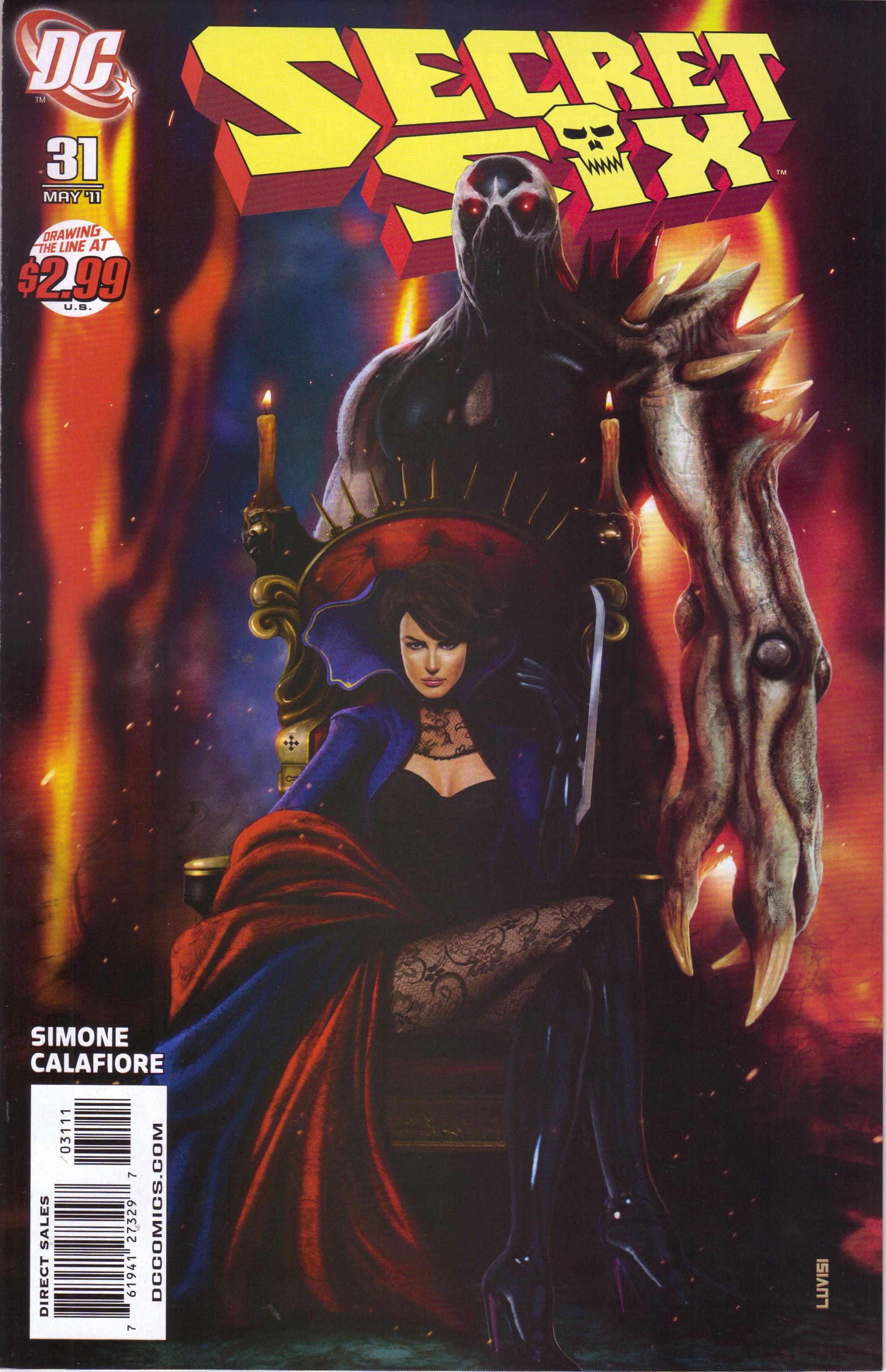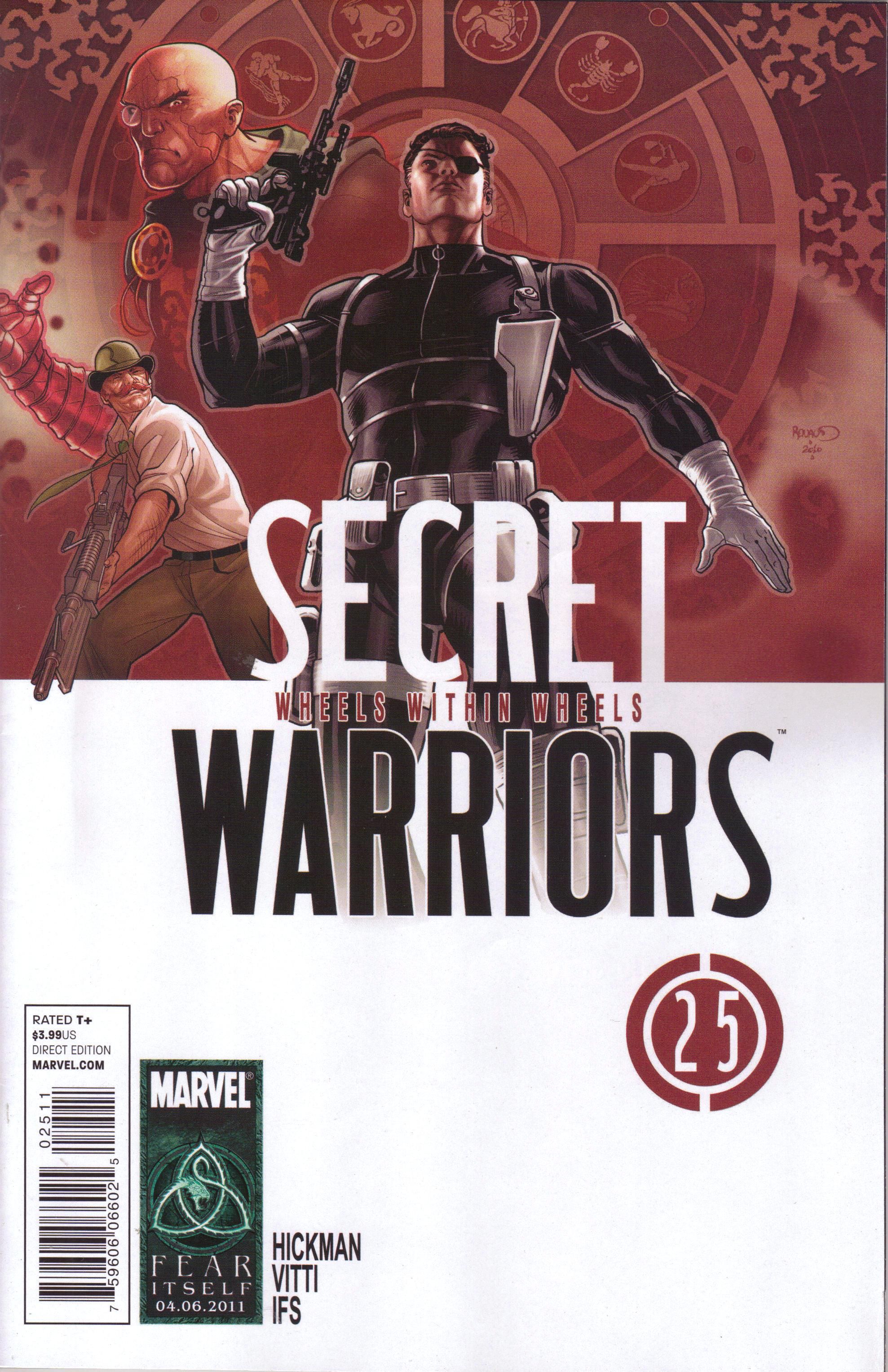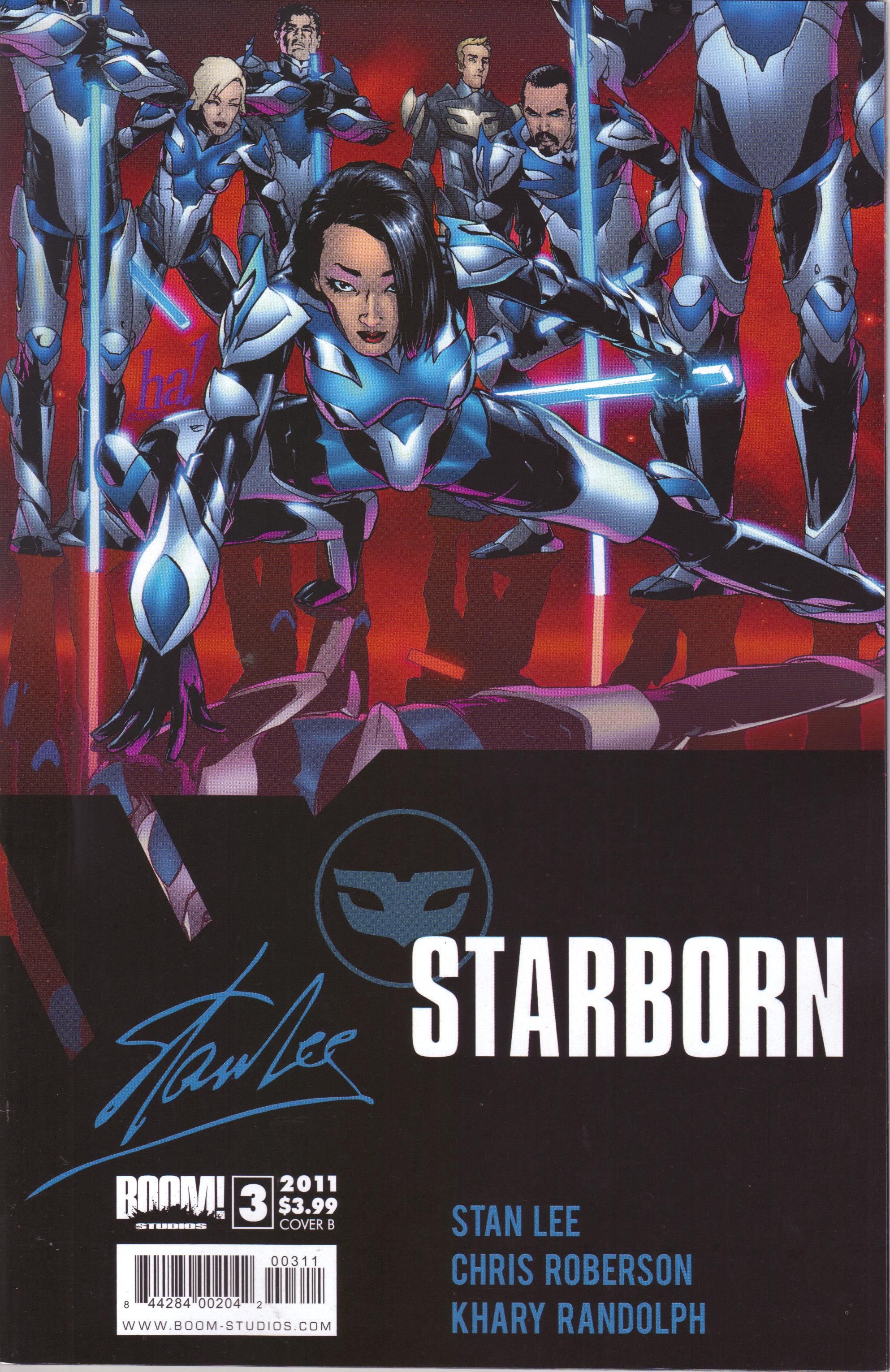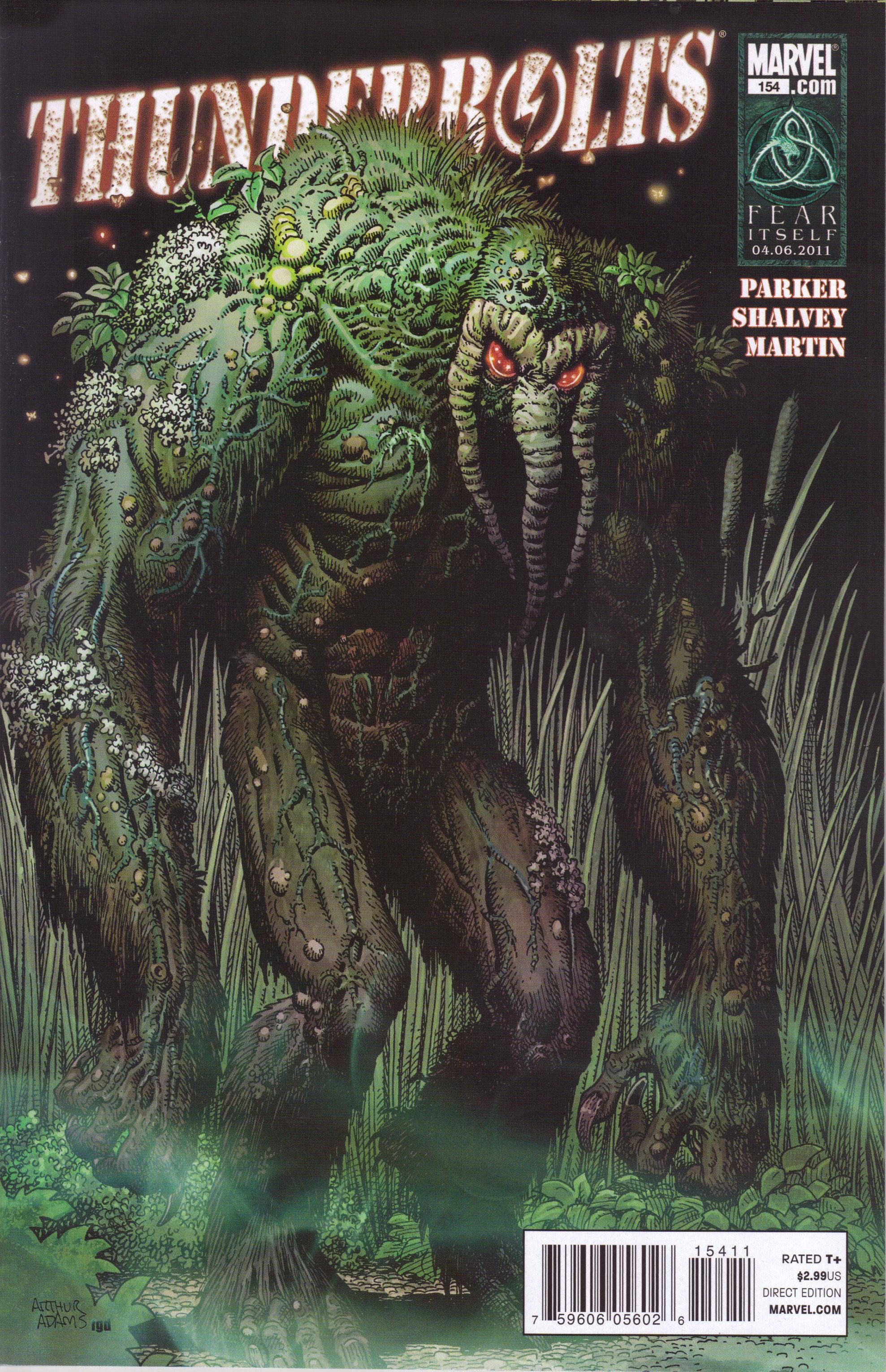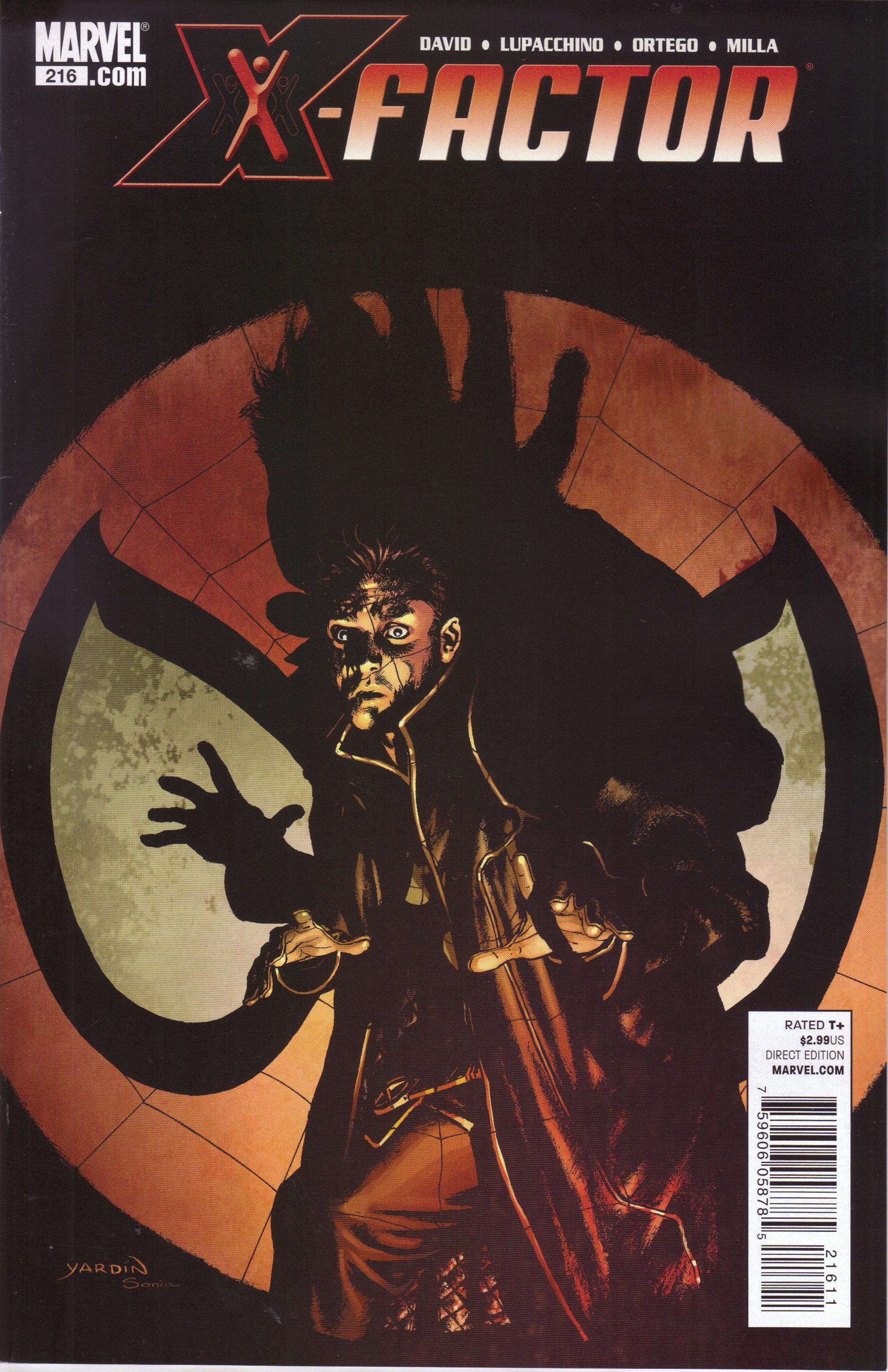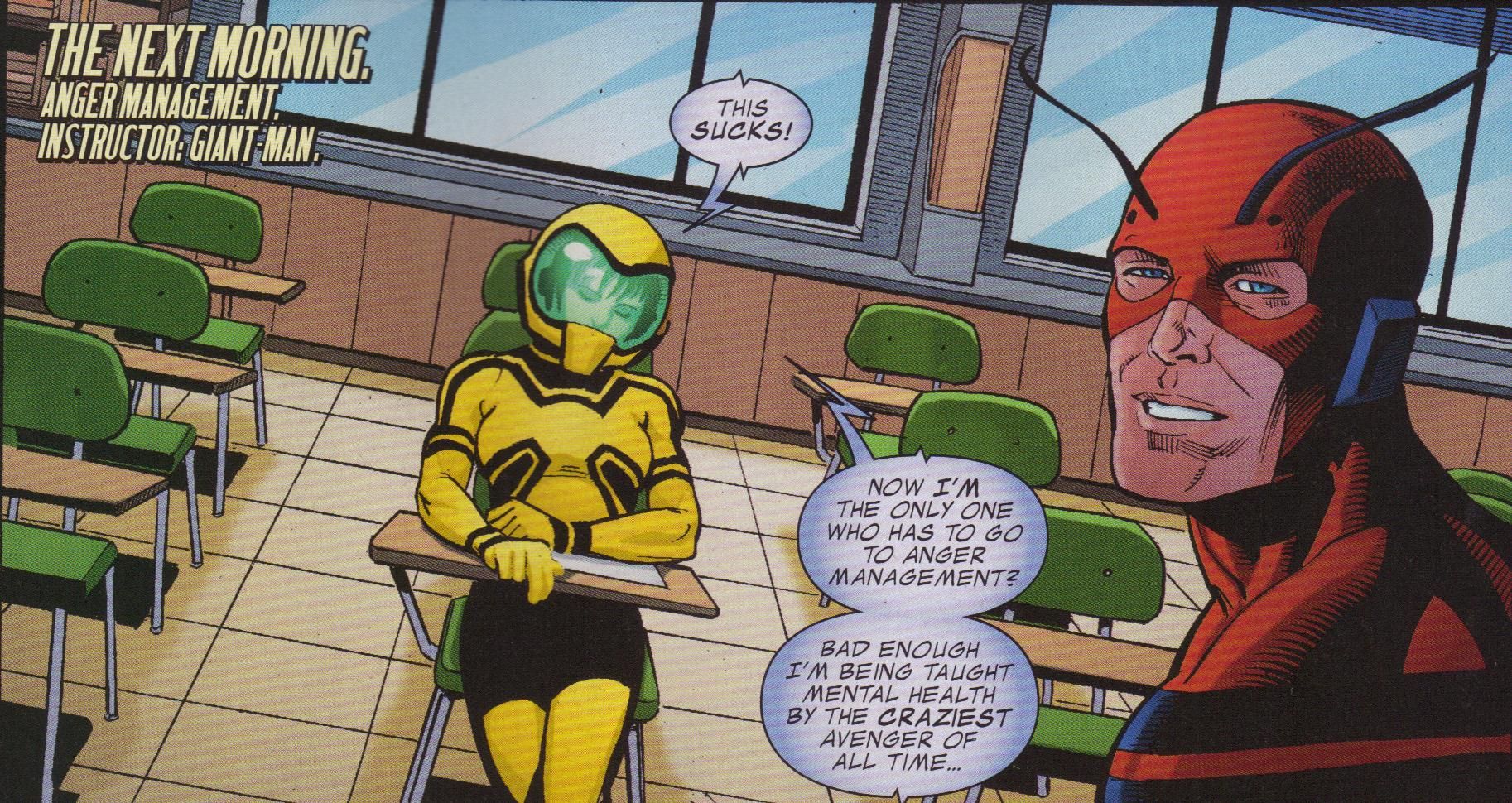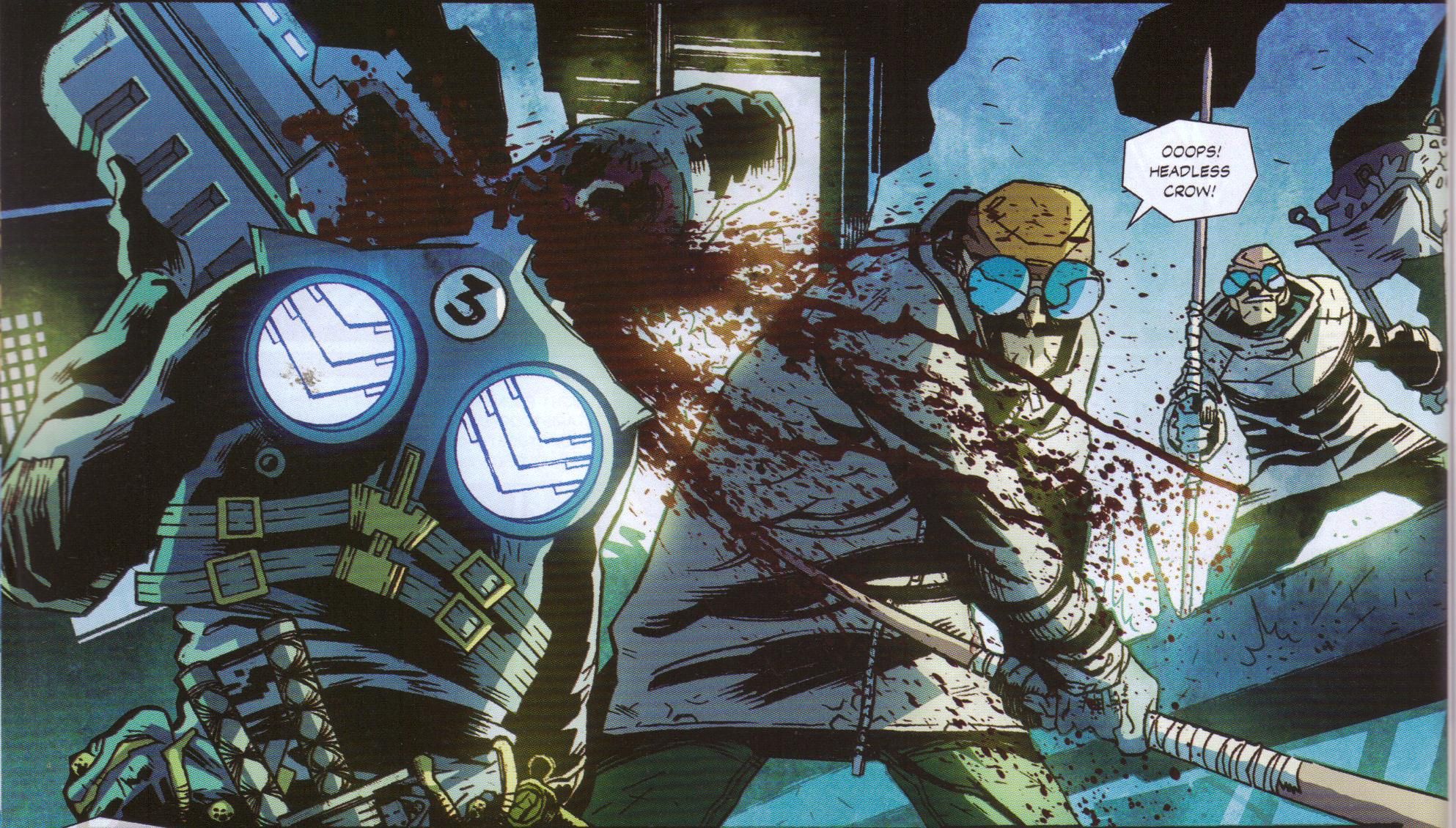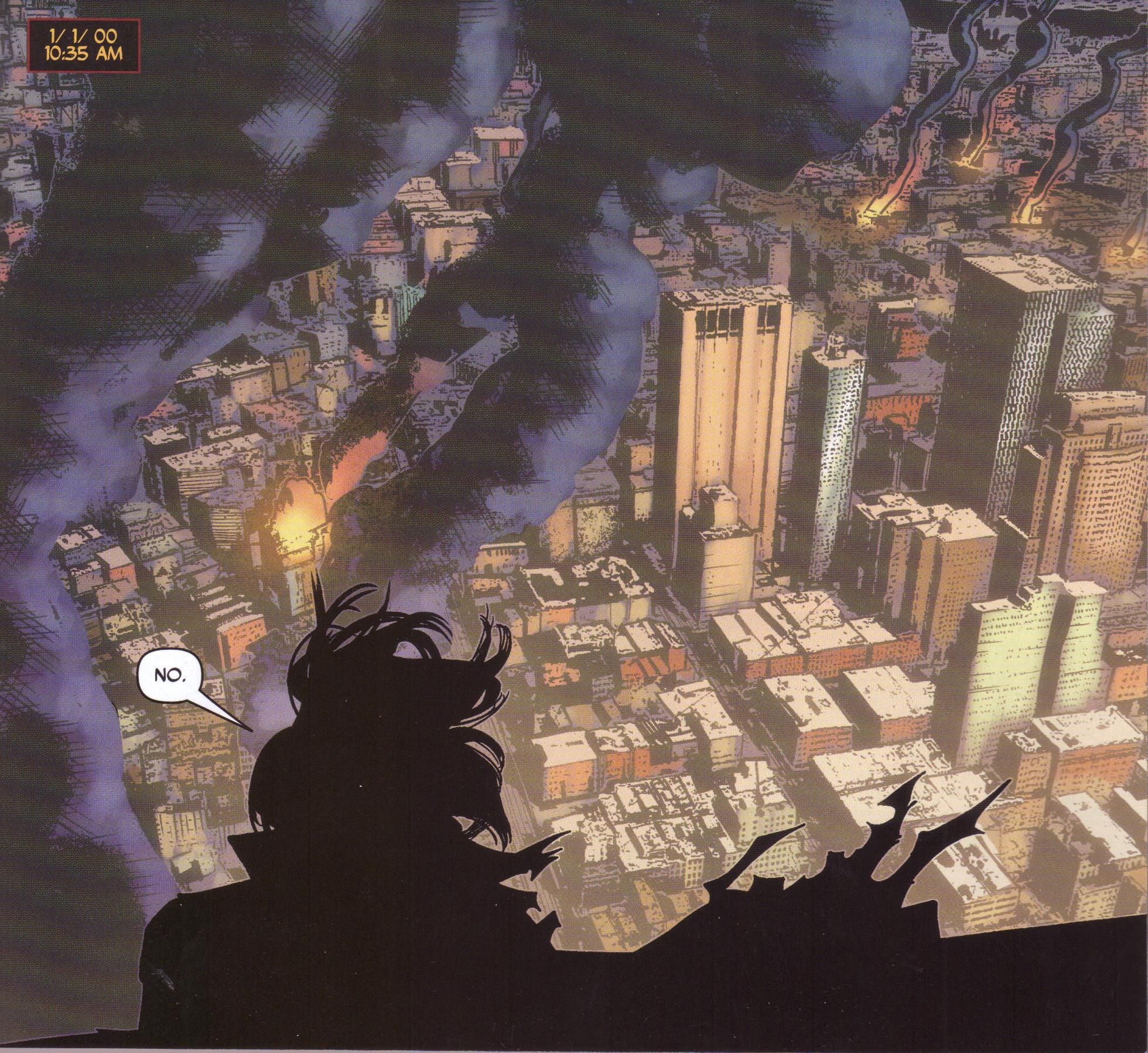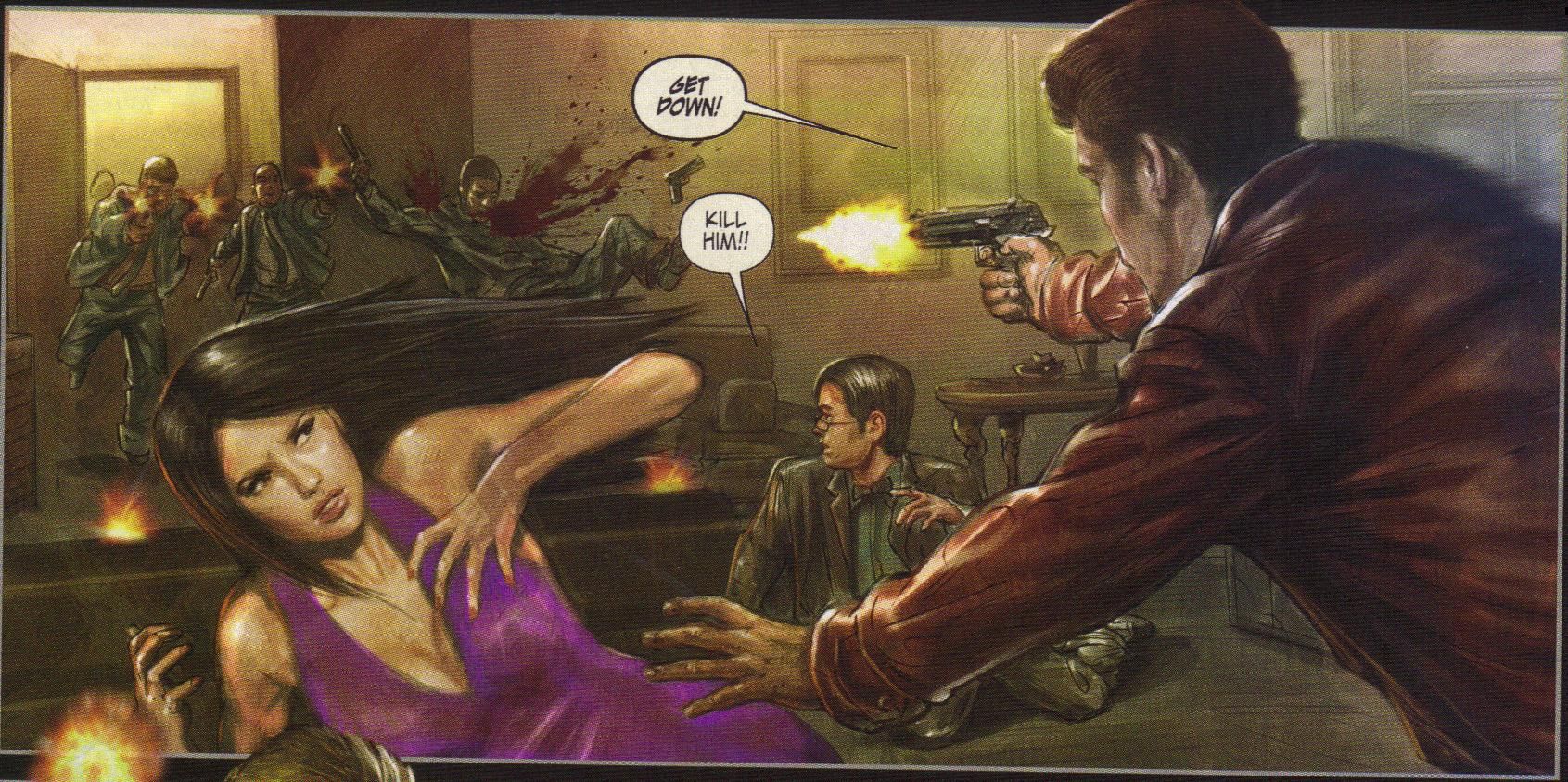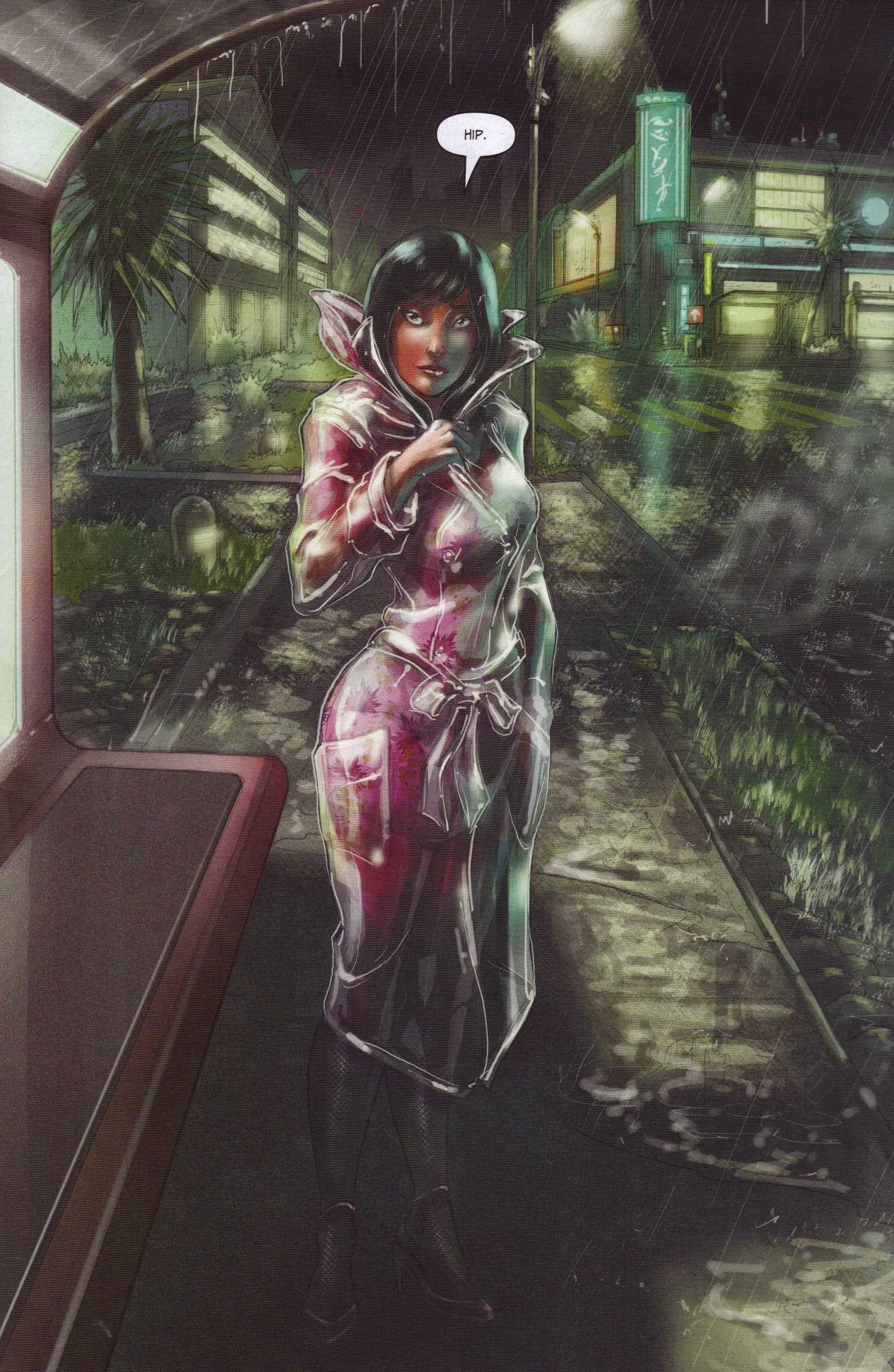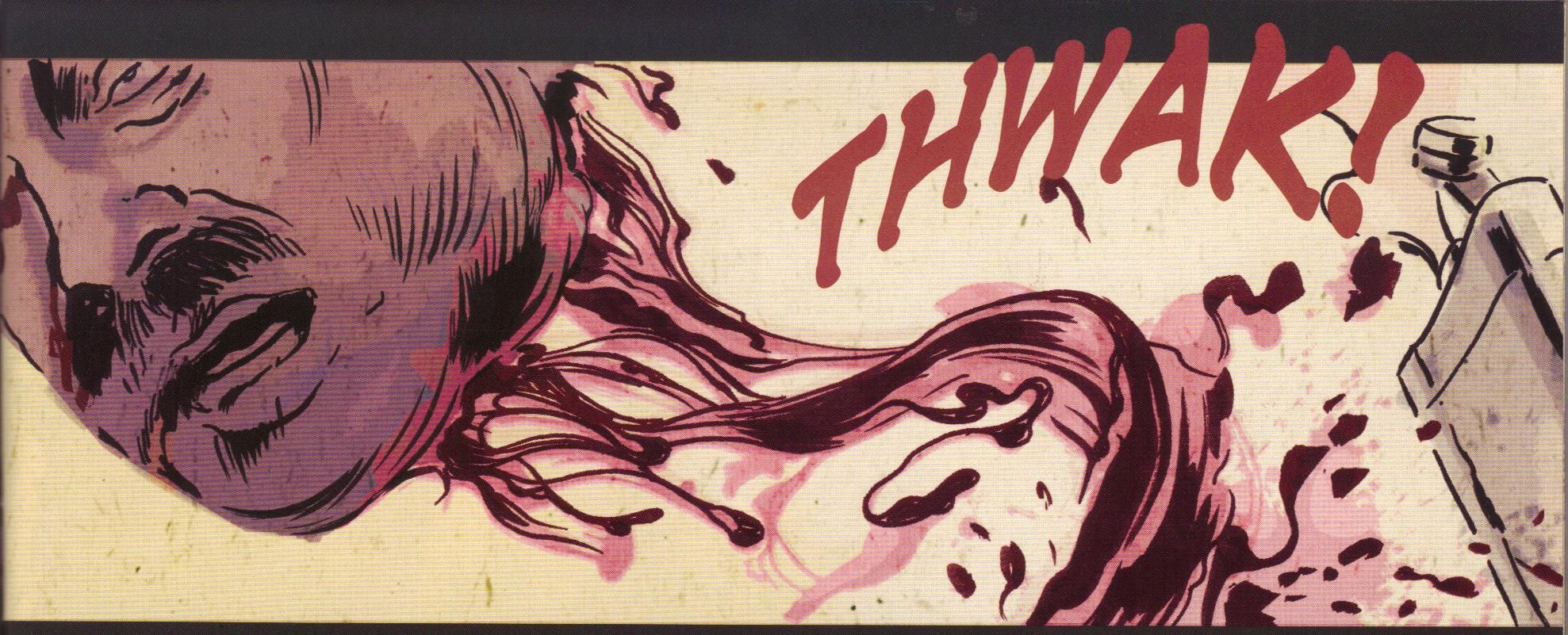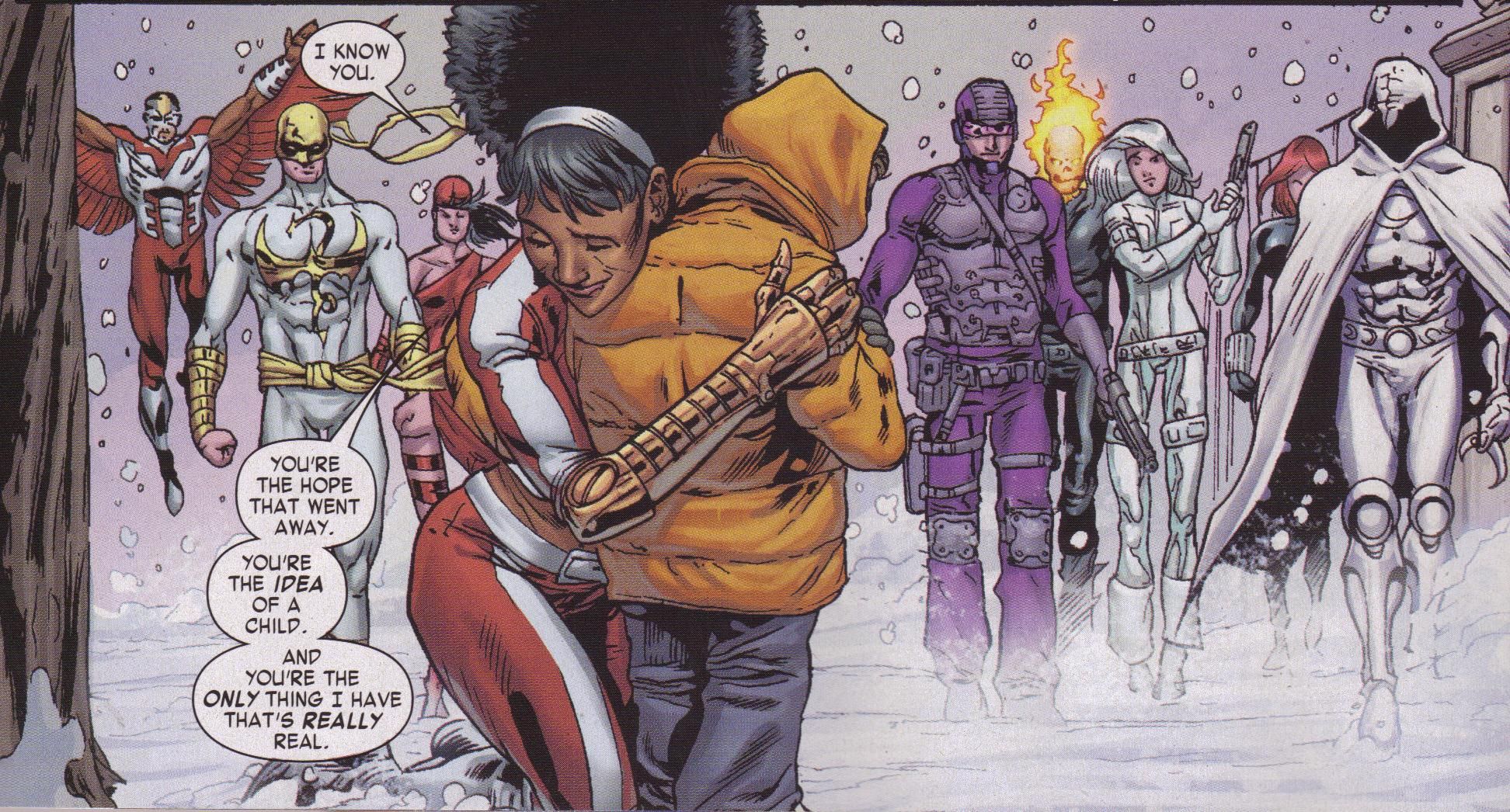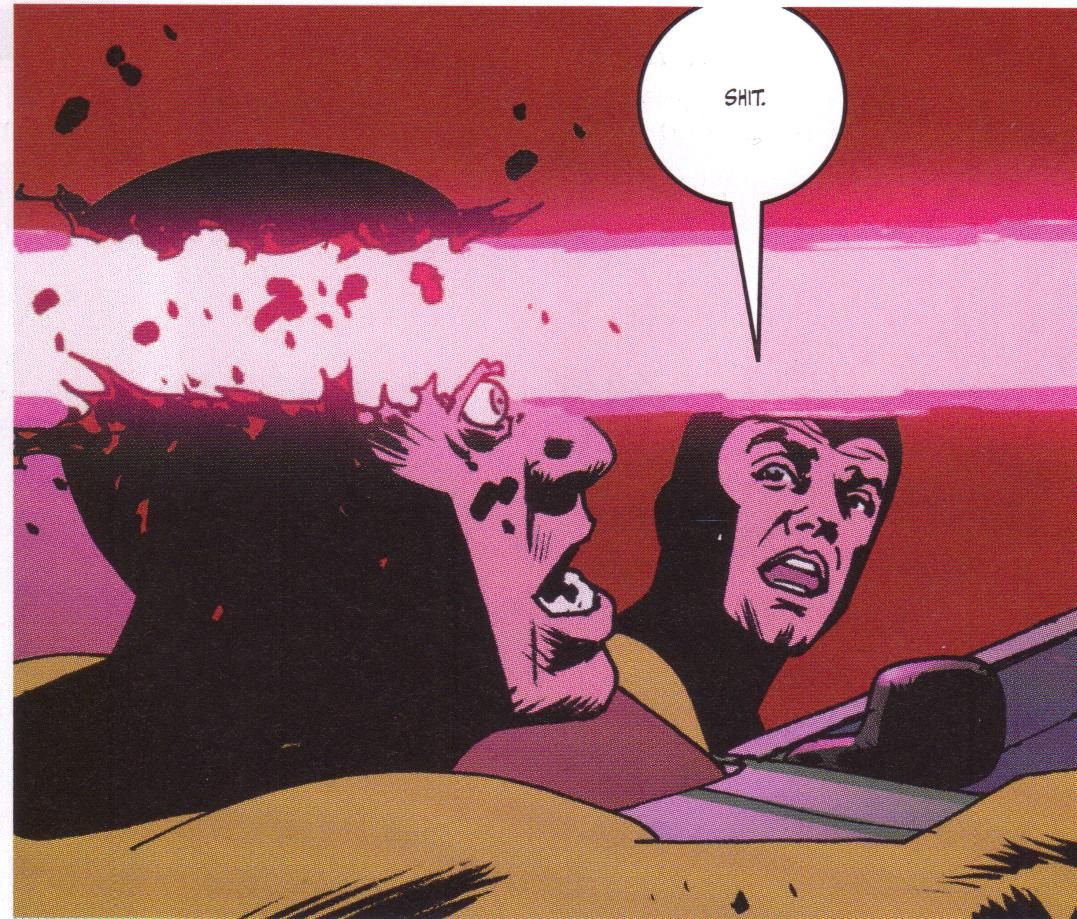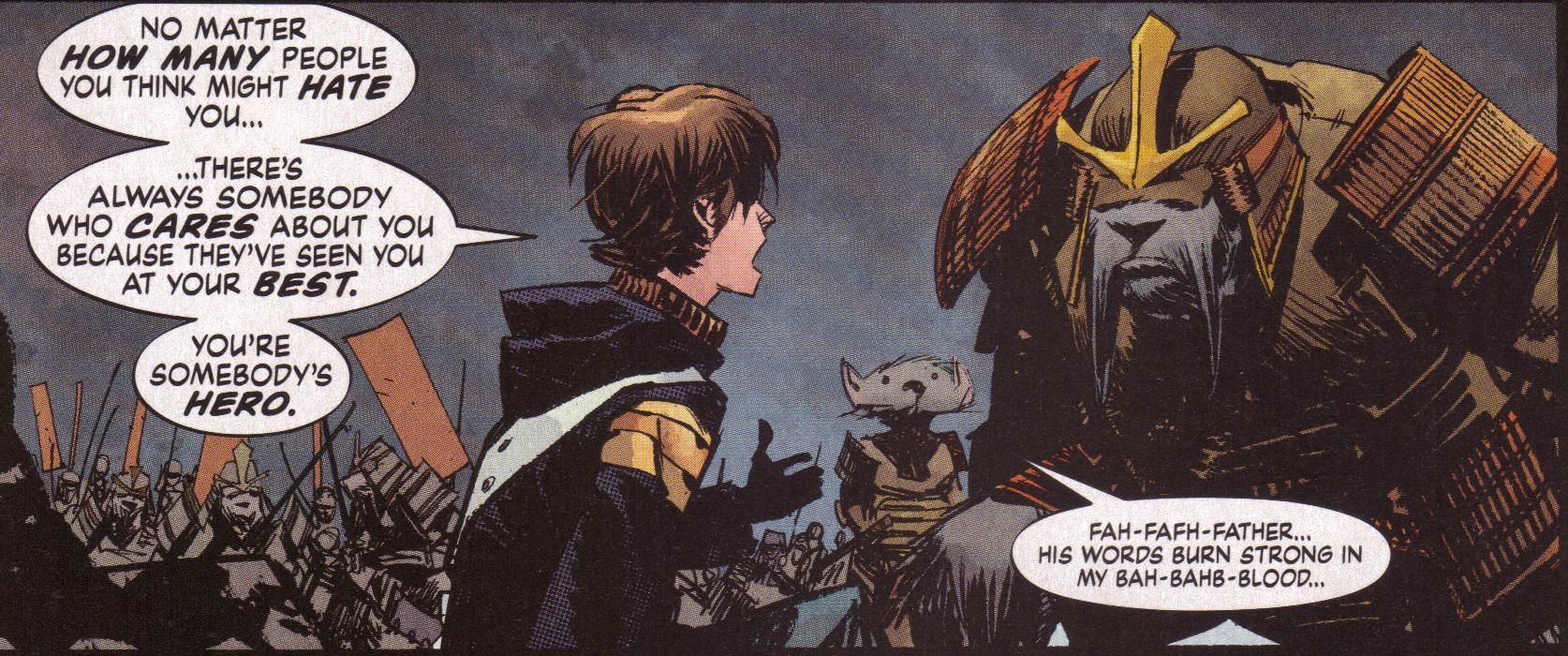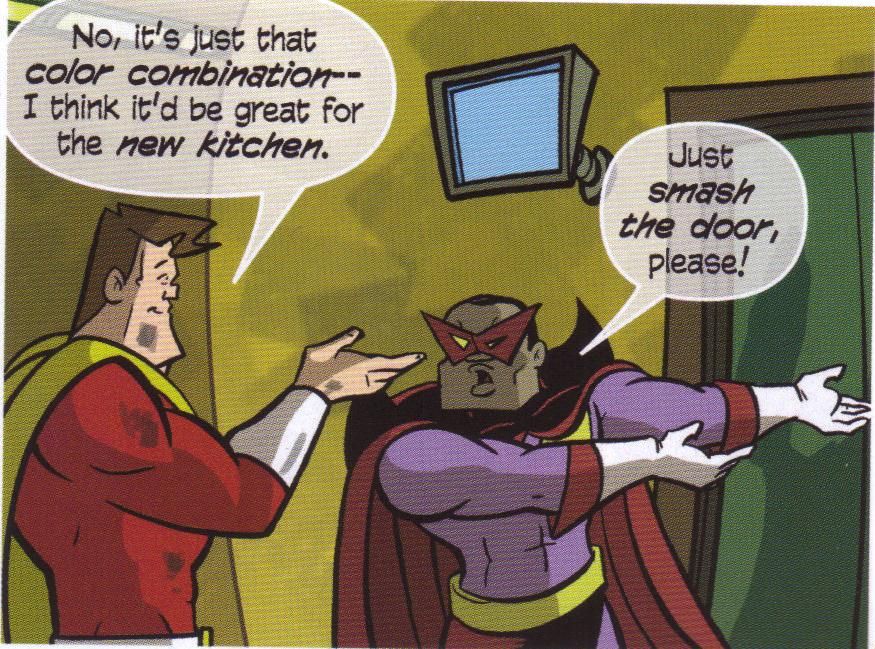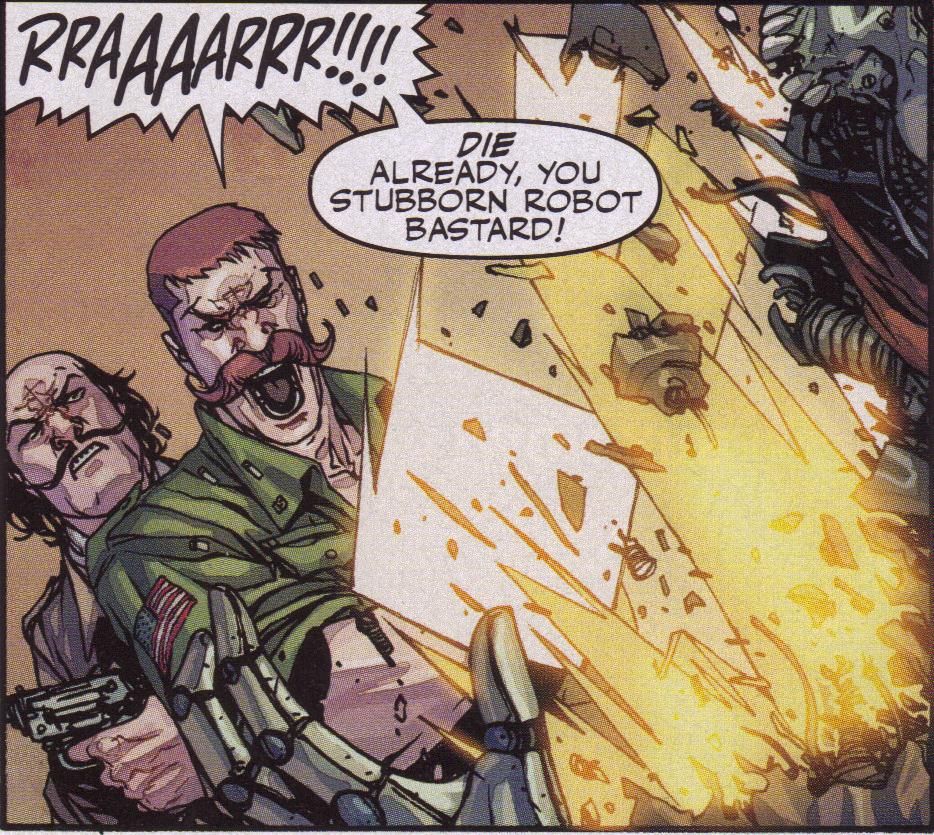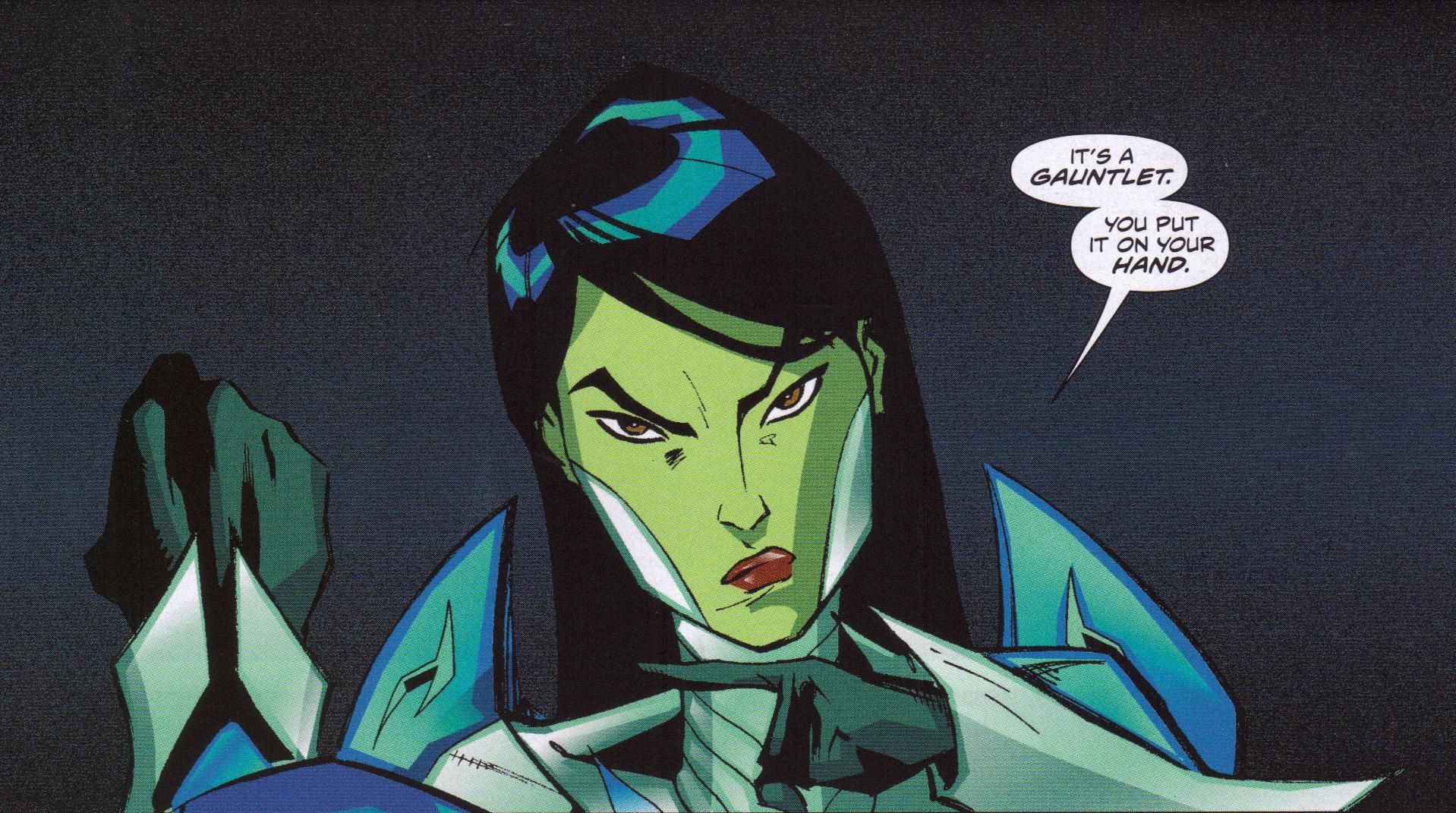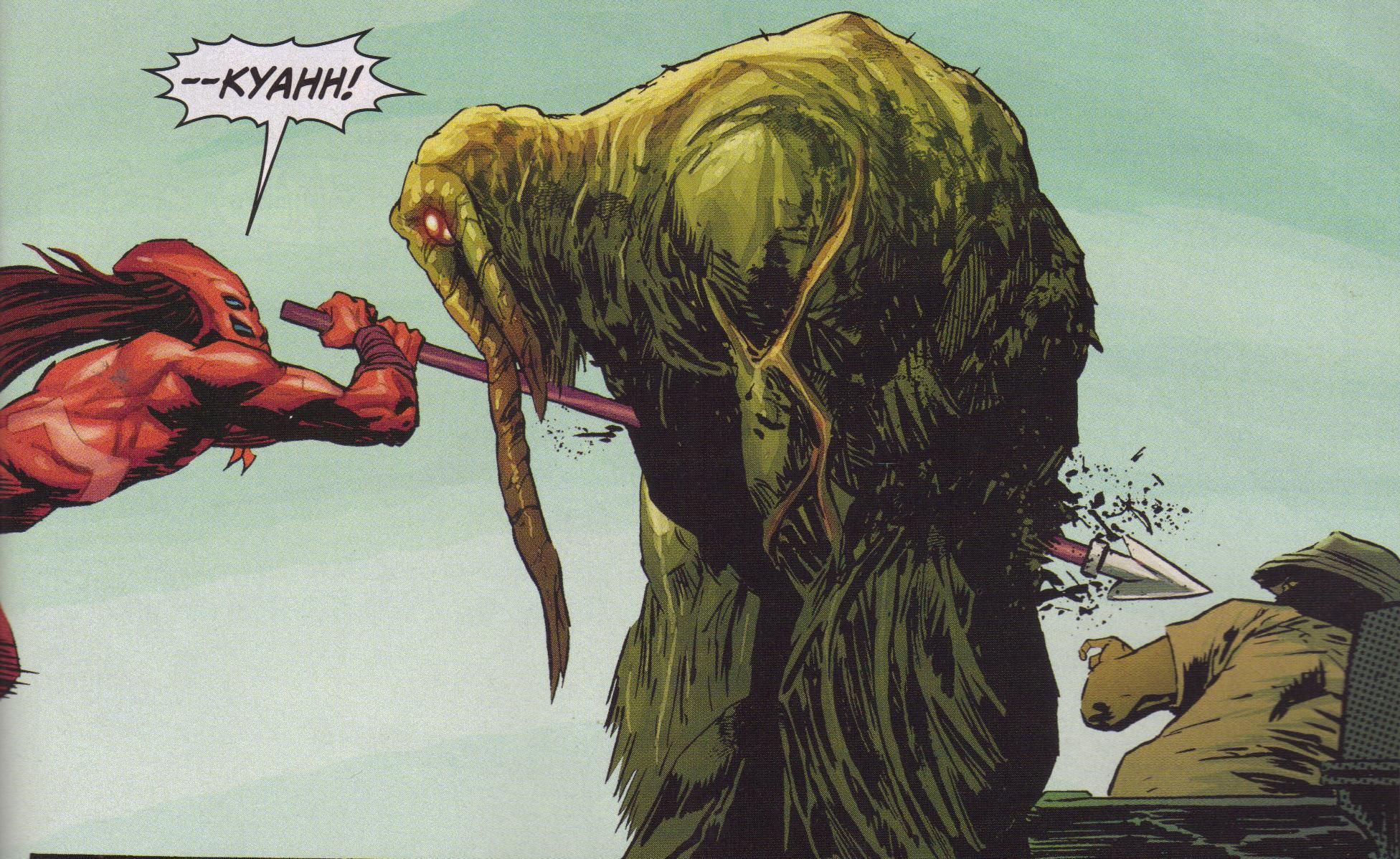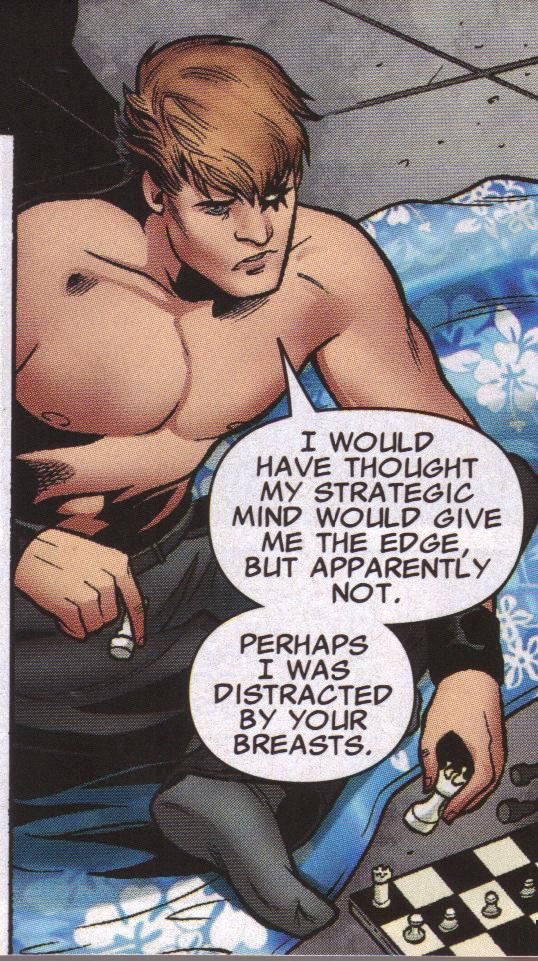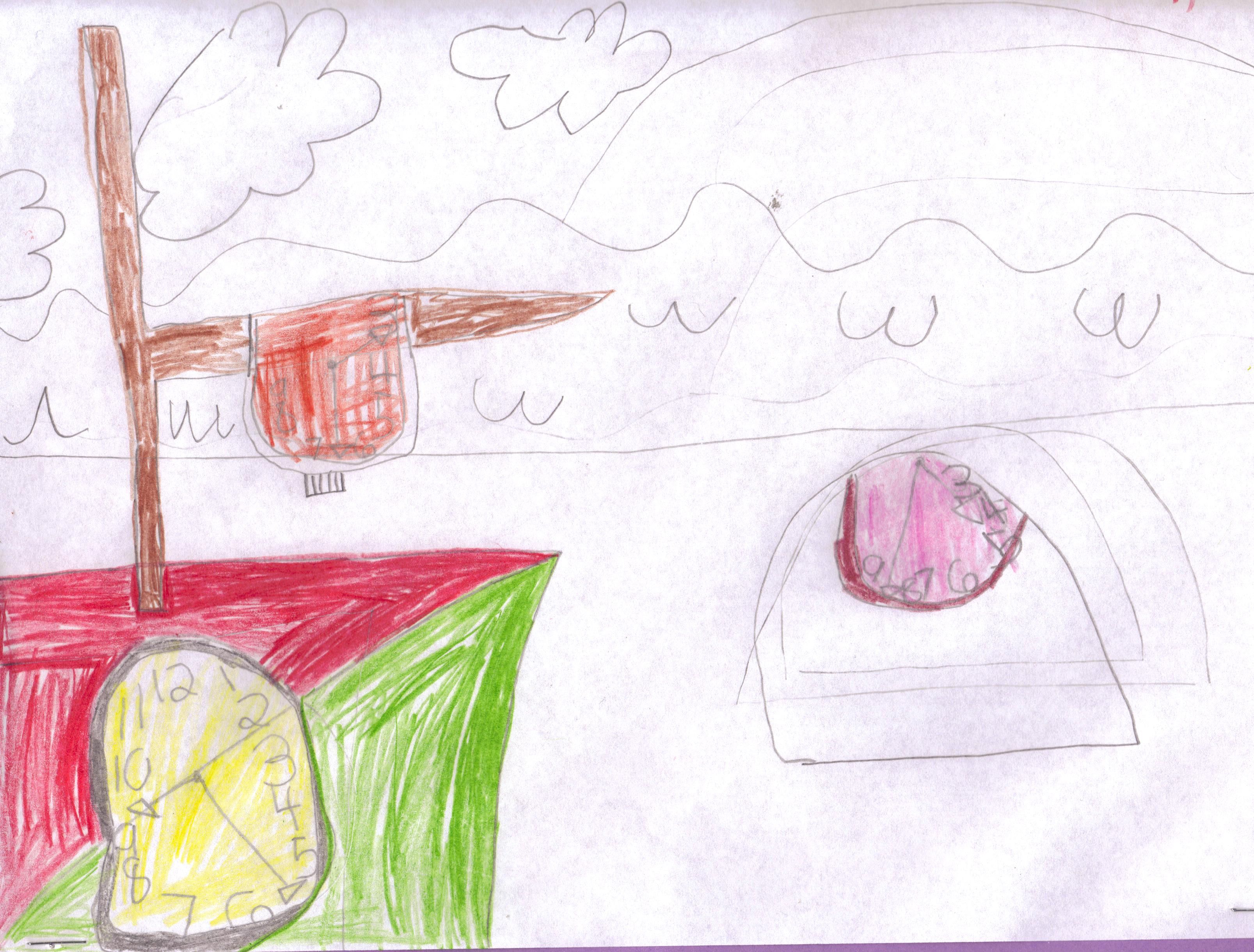"... No, it is impossible; it is impossible to convey the lifesensation of any given epoch of one's existence - that which makes its truth, its meaning - its subtle and penetrating essence. It is impossible. We live, as we dream - alone ..." (Joseph Conrad, from Heart of Darkness)
In honor of the week that was in Sheendom, all the captions in the Airwolf panels will be quotes by Mr. Carlos Irwin Estevez over the past week. If you haven't kept track of the Vatican Assassin Warlock over the past 7-10 days, well ... it's been fun. I even tried to match the quotes to the panels, but didn't quite succeed - I just had to have the final quote in here, because it's too freakin' amazing. If you're at all interested in his media assault, I give you many links (including his weird anti-semetic quote about Chuck Lorre - what's up with that, Charlie?): one, two, three, four, five, six, seven, and eight. Obviously, many quotes are repeated, but there you go.
Abattoir #3 (of 6) by Darren Lynn Bousman (creator), Michael Peterson (conceiver), Rob Levin (writer), Troy Peteri (writer/letterer), Bing Cansino (artist), Rodell Noora (artist), Dennis Calero (artist), and Andrei Pervukhin (colorist). $3.50, 22 pgs, FC, Radical Comics.
This isn't a terribly good comic, but halfway through the series, at least there's a weird mystery going on that seems to leading somewhere. That's something - not much, but something. Richard has gone on the lam because he's being accused of a crime he didn't commit, and he decides to dig into Jebediah Crone's history and find out what the hell he's doing. He finds out that Crone is really old and has been buying up houses where murders took place for a long time, but nobody knows why. So there's that. Plus, I guess we find out who the murderer is, unless it's just a random evil dude. Who the hell knows with this series, really?
I don't really have much else to say about this issue - the plot moves along, there's some gruesome gory "drawings," there's some investigating, and we're just going with the flow. It's not bad enough for me to loathe, but it's certainly not good enough to recommend.
Rating: ★ ★ ★ ★ ☆ ☆ ☆ ☆ ☆ ☆
One totally Airwolf panel:
Avengers Academy #10 ("Redemption Song") by Christos Gage (writer), Tim Callahan's Favorite Artist (penciler), Scott Hanna (inker), Jeromy Cox (colorist), and Joe Caramagna (letterer). $2.99, 22 pgs, FC, Marvel.
This is another solid issue in the series, which may sound like damning with faint praise, but I hope it's not - Gage has a very good handle on a large cast, and he's taking his time to give these kids a lot of different facets, which I appreciate. Hazmat, for instance, gets to go outside without her containment suit thanks to Leech, who shows up when Hank Pym decides she deserves a day off. It's not only a keen look at Jenny when she's not being all angsty, but her reasons for not wanting to do it again are well thought out and expressed perfectly. Meanwhile, Veil confronts Speedball (inadvertently) about his role in the Stamford debacle, which gives the group an excuse to visit the town and to discuss superhero culpability. I still think the folderol over Stamford is ridiculous - Nitro blows himself up, people, so what did you think he was going to do? - but Gage does a nice job with it and even allows a character to express my sentiment to Speedball. I even don't mind the ending, even though Veil is incredibly stupid, because she's a desperate teenager yearning for approval, so even though the end is this issue's Lumumba Moment, it still comes from how Gage has set up the character and what she thinks is important, so I can forgive her stupidity.
I really want Tim Callahan to stop by and explain why he hates Sean Chen's art so much. I'm far from Chen's biggest fan, but Tim really hates his work, and I don't get it. I get Tyler Kirkham hatred, because I share it. Chen is a largely inoffensive draughtsman who has very little flair and occasionally poses characters weirdly, but there's nothing outright eye-gouging about his work. Step up, Mr. Callahan, and explain your position!
Gage is doing a nice job with this comic, and I'm glad he's taking his time with the characters, because the pacing feels pretty good - sure, we get some action, but he's doing a very good job with the soap opera aspects. Everyone loves the soap opera!
Rating: ★ ★ ★ ★ ★ ★ ☆ ☆ ☆ ☆
One totally Airwolf panel:
Bodysnatchers #1 by Pasquale Pako Massimo (writer/artist), Barbara Ciardo (colorist), Giuseppe Boccia (color assistant), Raffaele de Angelis (color assistant), Andrea Plazzi (translator), and Adam McGovern (translator). $2.99, 24 pgs, FC, GG Studio.
I haven't been mentioning GG Studio and their spot in Previews, which they only recently occupied, but they publish Italian comics over here and many of them have a fairly slick, almost animated art style, which works or doesn't depending on the project and the talent. However, Bodysnatchers sounded kind of neat and has a much rougher style, so I thought I'd pick it up. The second issue is offered in this month's Previews (the book is already late; this issue was solicited in October), and I'll have to mull it over.
The story is somewhat confusing, partly because it's supposed to be and partly, I suspect, because of the translation. The book takes place in Utopolis, a dystopian futuristic city where strange squads of police called "eightballs" (some of them have that specific number on the tops of their hooded heads, but others have different numbers) roam neighborhoods participating in "sanitization runs," which seem to involve killing people. It's unclear why they do this or who they kill - in this issue, they kill one man who works for a city department, but we later find out that he was killed as the price for something else. The main character, Marta, is the dead man's wife, and she learns that her son, Ed, was on the sanitization run and that her husband was killed because Ed was allowed to join the Eightball Squad. One of Marta's ex-lovers shows up to tell her this and hint around at the main point of the book - no one in Utopolis gets older and bodies tend to disappear. Meanwhile, Marta's husband was obviously figuring something out, because his computer has come on and files are being deleted from it. It's very mysterious, but it's the first issue - I can live with it.
The fact that people don't get older makes it easier to accept that Marta, who begins the book by jumping off a building and apparently taking place in a revolution (the rest of the story takes place in the past), has a grown son, which bugged me until I reached that page. And given the name of the comic, I assume there's some sort of genetic harvesting going on, which is fine with me. The art is quite neat - there's a real tactile sensation to the city and the different levels to it - Marta's apartment is in the nicer section, and it's nice and middle-class, while other parts of the city are decaying well. Visually, the Eightball Squad is creepy - their hoods cover their heads completely, so their anonymity is secure. There are also some nice details to set the book in the future but not cut it off from our time - it feels like it could be a future, so there's that. And the story is certainly enjoyable, although I'm still confused about quite a bit - I guess there are two separate factions fighting over bodies, but Massimo is either being deliberately unclear or, again, the translation isn't great.
I don't love Bodysnatchers, but it's an intriguing science fiction story with some neat elements. You could certainly do a lot worse.
Rating: ★ ★ ★ ★ ★ ★ ☆ ☆ ☆ ☆
One totally Airwolf panel:
Chew #17 ("Flambé 2 of 5") by John Layman (writer/letterer), Rob Guillory (artist/colorist), and Steven Struble (color assistant). $2.99, 20 pgs, FC, Image.
Layman continues to do a marvelous job keeping all the plot elements of the entire series at play - the weird, chicken-flavored fruit, the "vampire" - while telling great little stories each issue, this time around focusing on a high school nerd who cracks and causes widespread mayhem at his school with some nasty recipes he cooks up. As usual, the way Layman tells the story (I'll get to Guillory in a second) is wonderful, from how the food fight escalates to how Tony discovers everything about the perpetrator (Layman's lettering is very cool in that section, too) to the way Layman shows that Olive is lying, plus the typical hilarious dialogue. As always, the issue zips right along, piling on subplots while managing to keep its focus. And I don't know whose idea it was to drop Olivia Dunham and Peter Bishop into the comic, but that was pretty funny.
Meanwhile, Guillory (whose wife had a baby in January, necessitating the delay of this comic) continues to dazzle. His food fight, which starts goofy before turning bloody, is beautifully drawn and colored very well, slowly going red as it becomes more violent. His flashbacks to what the nerd goes through are also colored red, and he adds some wide colored-pencil lines to the backgrounds to make it more "flashbacky." As always, the facial expressions are astonishing, especially when Peter (the "villain") finds out something has happened for which he'll be blamed but which he didn't do - he's scared and upset and horrified all at once, and Guillory nails it.
As usual, I can't praise Chew enough. If you're in Seattle this weekend for the convention, stop by Layman's table, say hello, and buy some Chew trades. Tell him I sent you - depending on what kind of mood he's in, he'll either be happy or punch you in the face. I can't predict it!
Rating: ★ ★ ★ ★ ★ ★ ★ ★ ★ ½
One totally Airwolf panel:
Days Missing: Kestus #4 (of 5?) ("Y2K"/"The First Fold Part Four") by Phil Hester (writer, "Y2K"), Trevor Roth (writer, "The First Fold"), David Marquez (artist), Rachelle Rosenberg (colorist, "Y2K"), Digikore (colorist, "The First Fold"), and Troy Peteri (letterer). $3.95, 25 pgs, FC, Archaia.
I've mentioned before that a problem with Days Missing is that we don't often see what the Steward "folds" away and what its consequences are before he manages to do so. That's not a problem in this issue, in which the Steward discovers a plot by one man to turn the Y2K scare into horrible reality, so he has to stop it. It's an interesting scenario and allows Marquez to draw some destruction, but the core of the issue is the fact that Kestus, the Steward's gal pal, has, in the years since the Steward convinced her to stop trying to fuck up humanity, put together a very efficient organization that helps her keep her promise. It's similar to what the Steward does, except they have to stop threats before they happen because they can't go back and fix it later. The events of 1 January 2000 also serve to bring the Steward and Kestus closer together, something which will play out in the next (final?) issue of the mini-series. So there's that. I'll have more to say when the series actually finishes, but it's moving along nicely.
Rating: ★ ★ ★ ★ ★ ★ ☆ ☆ ☆ ☆
One totally Airwolf panel:
Earp: Saints for Sinners #2 (of 5) by Matt Cirulnick (creator/writer), David Manpearl (creator), M. Zachary Sherman (writer), Colin Lorimer (artist), Kyushik Shin (colorist), and Rus Wooton (letterer). $3.50, 22 pgs, FC, Radical Comics.
More surprising to me than the fact that Earp #1 was a terrible comic is that several people defended it in the comments section of the post - not that they defended it; if they want to like Earp, who am I to say they shouldn't? I just didn't realize that that many people were reading Radical comics and commenting on blogs about them, so that's was surprising. But hey, if Radical is getting the word out about their comics, more power to them!
But ... that doesn't change the fact that Earp continues to be pretty bad. I mean, I don't like Abattoir either, and Abattoir is, on the surface, more unpleasant (read: gory), but Abattoir has a couple of things going for it: better art (in relative terms, as its art isn't that great) and a less derivative story. Two issues into Earp, and the writers are still hitting all the clichés - the girl from the streets who is now a kept woman but used to (and still does) love Jesse James; the noble Earps standing up to the correct cops; the lecherous villain trying to "prove" he's a man by raping the hot woman (he doesn't) - not to mentions lines of dialogue like "All the money in the world don't make you a man, Flynn." The comic's defenders pointed out that a lot of superhero dialogue is horribly clichéd, to which I respond, Sure it is. However, you'll notice I don't read a lot of superhero comics, and the ones I do I tend to think rise above the standard crap dialogue (I could be wrong) and if they don't, I try to call them on it. Also, as I pointed out last issue, every single line of dialogue in Earp is a cliché, so even if, individually, they don't sound that bad, over the course of 20 or so pages, it really builds up. Anyway, in this issue we get the story of Josie, who sang at a different casino because its owner, Flynn, kept her off the streets. When Jesse robs the place during one of her performances, we find out they have a history, and when Jesse tries to rescue her from Flynn, shit hits the fan. She's drugged but manages to escape to Earp's casino, which is why she was there when, in issue #1, Flynn and his men set it on fire. Now you know!
This is marginally - very marginally - better than issue #1, mainly because the art is consistent. Mind you, it's not much good, but at least it doesn't jump all over the place, style-wise, like issue #1 did. That's about all I can compliment this issue on.
So, Earp: still lousy. And oddly racist - the only black character in the book (unless I've forgotten some in issue #1) is a random punk stereotypically dressed in sideway-facing baseball cap and baggy pants that are falling down who gets run out of the casino by Morgan Earp, who tells him not to come back until he learns how to use a belt. That was weird. What the fuck, writers of Earp?
Rating: ★ ★ ☆ ☆ ☆ ☆ ☆ ☆ ☆ ☆
One totally Airwolf panel:
Elephantmen #30 ("Questionable Things Part Seven of Seven: Siren Song") by Richard Starkings (writer), Axel Medellin (artist), and Gregory Wright (colorist). $3.50, 26 pgs, FC, Image.
Oh, J. Scott Campbell. I know you have your fans, but man! that's a terrible drawing of Miki. I know guys will like it because she's in lingerie, but once you get past that, it's really a lousy drawing. I always like that Starkings gets different people to draw covers for Elephantmen, so I'm not going to worry too much about it, but I still don't understand Campbell's appeal. I guess it's just me.
With the end of this latest story arc, Starkings pulls some things together - a dude tells the Information Agency how easy it is to reactivate elephantmen and he offers to help pull them off-line, but they like the fact that they can turn their hybrids into killers at the push of a button, so they don't want his help. Meanwhile, Sahara's double returns to her club, and Starkings drops some hints about the future of the series. The main plot, however, is about Miki and Hip Flask. When last they saw each other, Miki was accusing Hip of getting her friend hurt and that she never wanted to see him again. However, over the past few issues she's started to experience her feelings for him again, so in this issue, she meets him, goes back to his apartment, and they get it on but good. It's a profoundly sad seduction, however, and Starkings does a magnificent job with it - Miki seems desperate, unlike the confident young lady we've seen in the past, and we get the feeling that she is adrift and wants to cling to something substantial, and a giant hybrid hippopotamus is fairly substantial. Hip himself knows that this can't end well, and his last thought before having sex with Miki, "This is going to hurt," backs that up - not only does it speak to the physical problems of sex between the two, but he knows that it can't last, yet he indulges anyway. Starkings has been building to this moment for a few years now, and he's a good enough writer to make it both a beautiful moment but one tinged with tragedy.
Medellin has been getting better on the book, and in this issue, he really does a nice job, mainly through the use of different styles. The parts at the Information Agency are much more straight pencil-and-ink, while the parts with Panya and Sahara and especially Hip and Miki are done differently - I'm not sure how much inking there is, and the colors look more painted, giving the pages are far more ethereal look than the mundane setting of the Information Agency. The scenes between Miki and Hip are much softer, and Wright colors it in blues and greens while the more solid pages are more brown. I think this is the first issue with nudity, and while we don't quite get full frontal male nudity, the fact that Starkings and Medellin don't try to hide what Miki is doing is fairly refreshing. This has been a "mature readers" book for its entire run, so there's no reason not to show nudity every so often, and the fact that Starkings has been restrained about it until now makes the entire seduction far more erotic than it might otherwise have been. It also makes it more disturbing, because of the hints of tragedy mixed with the eroticism.
This issue comes out next week, but Starkings sent it to me early, and as always, I'd like to thank him for it. This is certainly not a place to jump on board the book (that would be next issue, which is designed to be one), but it's a very good issue of a very good series.
Rating: ★ ★ ★ ★ ★ ★ ★ ★ ☆ ☆
One totally Airwolf panel:
Feeding Ground #4 (of 6) ("Severed Ties") by Swifty Lang (writer/story), Michael Lapinski (artist/story), and Chris Mangun (letterer/story). $3.95, 27 pgs, FC, Archaia.
As Feeding Ground moves past the middle section of the series and enters the final rush to the finish, Lang gives us a few answers but keeps enough mysterious that he still has plenty of ground to cover. Out in the desert, Flaca finally turns into a werewolf (or whatever the wolf things are), as we knew she would from the first issue, but what's interesting is how her transformation affects her family - her mother, of course, wants to help her, but the men in the family are torn on how to deal with her. When they catch up to her after a night during which she hunts and kills some game, they're confronted by Border Patrol agents, who have their own agenda. And so we hurtle forward!
One thing is puzzling but intriguing - at one point, Flaca's grandfather appears to be part of a Christian vision. I don't know what the crap is going on with that, but I'm curious. We shall see how Lang explains it going forward.
Lapinski is getting a bit better as the series moves along - his figures, while still very photo-referenced, are becoming a bit more fluid and less posed, which is nice to see. He still has some trouble with perspective within panels - there are a few drawings of two people in one panel who appear to be two-dimensional and simply posed next to each other when they ought to have more depth and be interacting with each other (yes, I know everything on the page is 2-D, but I mean that each character appears to be on the same "plane," where Lapinski clearly means for one of them to be further upstage than the other, and it doesn't look that way). But he's getting better, and the desert atmosphere is still very well done. This remains a unique-looking book, which is kind of keen.
I assume Archaia will keep sending me these, so I'll keep reviewing them. I don't know when I'll get the next one, but you'll be the second to know (after me, of course)!
Rating: ★ ★ ★ ★ ★ ★ ☆ ☆ ☆ ☆
One totally Airwolf panel:
Heroes for Hire #4 ("No Strings") by Dan Abnett (writer), Andy Lanning (writer), Robert Atkins (penciler), Rebecca Buchman (inker), Sandu Florea (inker), Jay David Ramos (colorist), and Joe Caramagna (letterer). $2.99, 22 pgs, FC, Marvel.
After three issues, we get a fill-in artist. Is it any wonder I hate when the Big Two announce a "new creative team" on a book? It's ridiculous. Maybe Walker has a very good reason for skipping this issue, but it's certainly not the first time this has happened on a comic. It's kind of annoying.
Anyway, in this issue, Misty wakes up when she figures out the life she's living isn't real. It's pretty much Abnett and Lanning showing her moving through her life with Danny and with her non-baby and her coming to the realization that someone is manipulating her, at which point she wakes up. Of course, the Puppet Master has an ace up his sleeve - you might think it's a stupid ace, but it's certainly an ace! So Misty isn't out of the woods yet!
I was kind of happy that Misty got out of her trap by herself and didn't get rescued by Paladin, but I'm sure that's coming next issue (what with the way this sucker ends). I always like when superheroes use their brains, and Misty has always been a smart cookie, so that was neat. Atkins is perfectly fine - he doesn't have the slick style that Walker has, but Ramos's colors help with that. I do wish that when Misty was "reliving" her life that she had different hair styles - I know that it's not reality, but she didn't always have this hair, and it would have been fun to see some of her other ones (she had a high-top fade in the early 1990s, for instance, and she rocked it!). But I guess I can live with the 'fro, 'cause it's groovy.
I don't know if Walker will be back next issue, but I'm sticking with the book anyway, at least until the first arc is done. It's moving along rather nicely, I must say.
Rating: ★ ★ ★ ★ ★ ★ ½ ☆ ☆ ☆
One totally Airwolf panel:
Incognito: Bad Influences #4 (of 5) by Ed Brubaker (writer), Sean Phillips (artist), and Val Staples (colorist). $3.50, 26 pgs, FC, Marvel/Icon.
Val Staples often lets me know that he appreciates my reviews of these Brubillips Icon books because I usually mention the colors. I've written about this before and I'll probably write about it again, but I mention the colors because over the past few years, as I've written more about comics, I've had to notice how much influence a colorist has on a book. Staples is one of the best in the business, and his color work on Incognito, especially (as opposed to Criminal, where it's still good but not quite as spectacular), is a reason why it's so good. Sure, Phillips's pencil work is strong and shows us the marvelous vision of the criminal underworld through which Zack moves, but check out, for instance, the panel below and the fluorescent pink laser, which pops right off the page and makes this even more pulpy than it already is. Just that color choice and the way it contrasts with the more drab colors of the characters and background highlights how strange this world is. I've used the term "lurid" to describe Staples's colors in Incognito before, but it's an apt term, I think, because it really makes Zack's world almost hyper-real, and then, when he's drugged toward the end of the issue, the coloring takes on even more extreme hues so that, as Phillips's layouts break down, so does Zack's filter on the world, and the colors almost assault him. Some colorists do this so well that the pencil work is fundamentally changed if those colorists don't work with those artists. I'm sure that Incognito and Criminal would be fine comics without Staples. With Staples, they border on masterpieces, even a somewhat disjointed narrative like this arc of Incognito. So, ponder that the next time you look at your favorite artist. Is he or she being well served by the colorist? Well?
Rating: ★ ★ ★ ★ ★ ★ ★ ½ ☆ ☆
One totally Airwolf panel:
Joe the Barbarian #8 (of eight) ("Tomb of the Iron Knight") by Grant "Yeah, it's six months late ... and I could have waited another six months and you'd still eat it up, fanboys!" Morrison (writer), Sean Murphy (artist), Dave Stewart (colorist), and Todd Klein (letterer). $3.99, 32 pgs, FC, DC/Vertigo.
As much as I like Joe the Barbarian (and I do, a lot), I wonder why it's so late. It follows a narrative arc that has very few surprises, unlike some of what the God of All Comics has written in the past, so I can't believe he needed to do rewrites to change the fundamental direction of the plot. Morrison is doing this more and more - how late is the third issue of Batman, Inc.? - and it bothers me quite a bit, because I have the feeling he just doesn't care anymore. Which is fine, but then don't start shit. As much as I love Morrison (he's my favorite comic book writer, after all), if he never wrote anything again, I'd get over it. I'd much rather he not start something than have him start something and then either get bored and give up or noodle around with other shit until he bothered to finish it. I know this will read wonderfully in the trade and the delay will be forgotten, but it still bugs me. I heard or read somewhere that Morrison is essentially finished with doing stuff like this and is going to concentrate on the increasingly small circle-jerk of DC continuity into which he's been swirling for years now (and hey, wasn't Multiversity supposed to be out in 2010?), and that makes me sad, but at least he could have gotten off of his ass and put this together a bit sooner before figuring out on which buttock Batman's pimple appeared in World's Finest #6,726,373 from 1955 so he can write a six-part epic about it. Am I bitter? I suppose so. Mainly because I get angry when artists are late all the time, so why can't I be angry when writers are? Murphy, I should point out, drew an entire five-issue mini-series since issue #7 of this series came out, plus at least one other issue of a random DC book (some Titans thing, right?), so I doubt if it was him. I suppose I should just move on ...
Chad Nevett is unimpressed with this mini-series, because he remains "unaffected" by it - he doesn't explain further. That's interesting, because while I'm "unaffected" by it as I wasn't by, say, the end of Doom Patrol, I still maintain that this is far superior to Morrison's Batman work, mainly because the Batman books are Morrison playing with toys in inventive ways - it's fun to watch, but at the end of the day, it's still someone playing with toys. While Joe lacks the emotional heft of some of his greatest work, there are still higher stakes than anything in Batman, and Morrison has worked hard to make both of Joe's worlds important to him and, by extension, important to us. I've been more thrilled by Joe's dilemma than almost anything Morrison has done on the Batman books over the past five years - yes, part of that is Murphy's stunning art, but it's also because when Morrison wants to, he can pack huge emotional wallops into very few words, and he's done that a lot in this series. Of course Joe wins in the end (sorry, SPOILERS, yo!), but that's not the point. The point is how he and Jack and Smoot and Zyxy become heroes, and how his father remains the biggest hero of them all. This is a marvelous comic, and I urge anyone who hasn't been reading it to get the trade. Even if you don't love the story because it's a bit predictable, you will love Murphy's art. If only the GoAC cared enough to give us more comics like this. Oh well.
Rating: ★ ★ ★ ★ ★ ★ ★ ★ ½ ☆
One totally Airwolf panel:
Love and Capes: Ever After #2 (of 5) by Thomas F. Zahler (writer/artist). $3.99, 24 pgs, FC, IDW.
As usual, each issue of Love and Capes is somewhat difficult to review, as it's just a collection of webcomics that basically consist of four-panel gags that eventually tell a story but often finish a brief tale in the middle of an issue before moving onto the next story. Zahler does manage to keep a theme going throughout many of the issues - in this one it's that the parents are visiting and Mark decides to tell Abby's parents that he's a superhero. The fact that he get turned into a little kid (as seen on the cover) is a minor subplot in the book, but it does make a compelling cover, which is probably why Zahler used it. Mainly, this issue is about Mark bonding with his in-laws, especially his father-in-law, who's always been a bit leery of Mark (he took his little girl away, dads can't deal with their female children having sex, you know the drill), and Zahler does his typically nice job with it. The jokes, as always, are funny, there's a tiny bit of actual superheroing (which is deliberately off-panel most of the time), and Zahler, who lives in Ohio, dates the comic a bit because LeBron James still plays for the Cavaliers. At least I assume he drew this before last summer - maybe he's just indulging in some wishful thinking. This is a just a solid, charming comic book. I enjoy it quite a bit.
Rating: ★ ★ ★ ★ ★ ★ ★ ☆ ☆ ☆
One totally Airwolf panel:
Next Men #4 by John Byrne (writer/artist), Ronda Pattison (colorist), and Neil Uyetake (letterer). $3.99, 22 pgs, FC, IDW.
Byrne backs up a bit to tell us who's in the weird black metal suit from last issue, and it's quite a doozy. I have no idea how it's going to work, but what the hell - it's just so COMICS! that it has to make sense, right? This is actually a fairly straight-forward issue, as opposed to all the time travel jumping we've been doing over the past few pamphlets, as Byrne takes Jasmine, Nathan, and Bethany to a big ol' particle accelerator where Tony is waiting for them. This being comics, not only does the accelerator's test go wrong, it goes wrong spectacularly, and somebody dies and somebody else becomes inconvenienced for 200 years. Yeah, that has to suck. It's all very wacky, but Byrne does wacky comic-book science very well, and after so much jumping around, it's nice to have a narrative that goes from one point directly to the next point in time instead of switching realities and/or time periods. Byrne doesn't explain anything except who's in the weird black metal suit, but that's okay. I always like to read Byrne's work as a giant whole anyway, when the entire tapestry is revealed. Right now I'm just along for the ride.
Rating: ★ ★ ★ ★ ★ ★ ☆ ☆ ☆ ☆
One totally Airwolf panel:
Secret Six #31 ("The Darkest Hour Part One of Three: In Every Dream a Nightmare") by Gail Simone (writer), Jim Calafiore (artist), John Kalisz (colorist), and Travis Lanham (letterer). $2.99, 22 pgs, FC, DC.
I've mentioned this before, but one key to Secret Six being so good is that the characters are not necessarily friends. Too many comic book writers think that characters need to be either best buds or mortal enemies, but there are a lot of shades in between that, and while some of the team might be more friendly with some than others, none of them are really friends - even Deadshot and Catman's bromance doesn't mean they're best friends, and Bane's protective attitude of Scandal is more paternalistic than anything. So Simone lulls us into a false sense of security about these characters, making us believe that just because they're not at each other's throats all the time, they're pals, but that's just not true. (Even if, through their dialogue, she often reminds us they're not really friends, readers often react to that by thinking it's just playful banter and not deadly serious.) What this means is that when something divides the group, as it does in this issue, the vitriol the characters display toward each other is more real and more biting than we expect, and even if we're shocked, Simone can easily point out that, hey, she never said they were friends. It's just one reason Simone is a good writer. I know, duh.
Simone also plots things very well. In this issue, Scandal's stripper girlfriend returns, and as the solicits have given away that this arc is about the "get out of hell free" card that the team picked up in the series' first arc and Simone shows us that some creepy dude is stalking Liana, we naturally assume that's where the book is going. But then Scandal has a dream about Knockout, and we're reminded that, whoops, she already knows someone in hell. So is that what the arc is about? Well, someone else on the team lost someone they love, too, and perhaps Rag Doll would like to use the card. Oh dear. Hence the fact that two team members are suddenly at each other's throats, and nothing goes well for anyone. The team heads to hell, but Black Alice doesn't go, another wonderful little character moment - in a normal book, she'd be scared but overcome it because she's a hero. In this book, she's scared but doesn't overcome it because she's just a person. It's a powerful moment that works very well.
Obviously, I love this series, and a great deal of it has to do with the way Simone constantly challenges the reader with these devastating plots and interactions that reveal so much about the characters and who they are. We might think these characters are despicable, and they certainly do despicable things, but the reason the book is so good is because they don't only do despicable things - they act like people, not like stereotypes. Simone is fearless about the characters, too - I honestly don't know if Liana is going to survive, or even if every team member will come out of hell. It's exciting to read an issue of Secret Six, because Simone keeps you on the edge of your seat. I mean, how can you not love that final page????
(I was confused about Rag Doll disappearing, though. How did he do that? Is he dead? If so, why did he disappear like that? Can he teleport? I don't recall that. Can anyone explain?)
Rating: ★ ★ ★ ★ ★ ★ ★ ★ ½ ☆
One totally Airwolf panel:
Secret Warriors #25 ("Wheels Within Wheels Part Two") by Jonathan Hickman (writer), Alessandro Vitti (artist), Imaginary Friends Studio (colorist), and Dave Lanphear (letterer). $3.99, 31 pgs, FC, Marvel.
Hickman ties this issue into S.H.I.E.L.D. nicely, as Leonardo da Vinci gathers the people who will become S.H.I.E.L.D., Hydra, and Leviathan together in 1961 and turns them loose on the world, tantalizing them into playing a game with global stakes. Bad things happen, Leviathan and Hydra appear to "win," Leonardo doesn't care that he basically created the two terrorist organizations, and it all leads back to Fury being kidnapped at the end of last issue. The one thing I'm confused about is what happens to Nick's brother, who of course becomes the super-villain Scorpio in the 1970s. I assume Hickman will explain it, because Fury deliberately withholds the information about it from Leonardo. We shall see.
At this point, with three issues left in the series, there's not much to say except to watch how it plays out. Hickman is putting all the pieces together, but it's obvious that after the attack on the Hydra base that devastated the team, he's filling in the backstory to build up to the finale. Now is now a good time to jump on board, but I'm looking forward to the final few issues.
Rating: ★ ★ ★ ★ ★ ★ ½ ☆ ☆ ☆
One totally Airwolf panel:
Starborn #3 by Chris Roberson (writer), Khary Randolph (artist), Mitch Gerads (colorist), and Ed Dukeshire (letterer). $3.99, 22 pgs, FC, Boom! Studios.
Starborn #3 came out a few weeks ago (issue #4 comes out next week), but my store didn't get their shipment until this week, hence the late review. I'm sure you can still find copies if you've been waiting until I review it to pick up your copy!
Roberson is doing a nice job on this series, as he makes sure we're all up to speed with what's happening (Benjamin created a strange science-fiction world that turns out to be real and he's the heir to a great deal of power, but he doesn't remember that it's real) and keeps the exposition moving while making sure there's plenty of action. He balances the talking with the fighting very well, and that means Randolph has plenty of cool, weird characters to draw (the Pride!) and things blowing up and shit. As Tara and Benjamin manage to escape the killer drones that were after them, we get a bit more explanation in this issue, but that doesn't mean things don't blow up! Plus, Roberson's script is just silly enough that we don't get bogged down in ponderous prose, so everything is very light and zippy. Starborn is a very nice action/adventure comic, and I do hope Randolph sticks with it for a while - he's a big part of its success.
Next week: issue #4! Here already!
Rating: ★ ★ ★ ★ ★ ★ ½ ☆ ☆ ☆
One totally Airwolf panel:
Thunderbolts #154 by Jeff Parker (writer), Declan Shalvey (artist), Frank Martin (colorist), and Albert Deschesne (letterer). $2.99, 22 pgs, FC, Marvel.
Poor Arthur Adams. There he is, drawing a nifty Man-Thing that was either commissioned as a cover or just used as one, and he signs it and everything, but Marvel still credits Greg Land with it. That kind of has to suck, doesn't it? Anyway, ARTHUR ADAMS DREW THIS COVER! Don't say it's a nice Greg Land cover, because it's not!!!!!
Parker gives us a Man-Thing solo story, as Jennifer Kale (yes, Jennifer Kale) shows up and spirits him away to the Everglades so he can resume his job of defending our reality from extra-dimensional threats (in this case, red-skinned, six-eyed humanoid-y creatures who ride giant lizards). The team finally learns who Man-Thing used to be and how he became Man-Thing, which is nice, and of course he decides that hanging out with the Thunderbolts is pretty keen, so Kale doesn't try to convince him to return to the swamp. Basically, this is an issue to explain a bit about Mr. Sallis and show his importance to the team, which sets up a presumed guest appearance by Dr. Strange next issue, as the powers-that-be have decided the T-Bolts need another team member with magical experience. So there's that.
Shalvey is a good fill-in artist, because he has a bit of Kev Walker's style without being a complete clone, so the book's tone remains the same but allows a different artist to show off a bit. Shalvey is a bit rougher and less fluid than Walker, but he also does a very nice job with the weird invaders and their lizard-mount, which is pretty important in a comic like this. I don't know if Shalvey's style would work on a slicker superhero comic, but he's good for stuff that's a little bit creepier (well, as creepy as a mainstream Marvel book can get), so I'm glad he got a chance on this title.
Thunderbolts continues to be a nifty comic with some cool ideas and interesting characters. Isn't that all we really want?
Rating: ★ ★ ★ ★ ★ ★ ★ ☆ ☆ ☆
One totally Airwolf panel:
X-Factor #216 by Peter David (writer), Emanuela Lupacchino (penciler), Guillermo Ortega (inker), Matt Milla (colorist), and Cory Petit (letterer). $2.99, 22 pgs, FC, Marvel.
I'm very happy that nobody at Marvel seems to be paying attention to X-Factor, because that means that nobody is trying to put Emanuela Lupacchino on a higher-selling comic that I have no interest in reading. I'm perfectly happy to see her work on 2 out of every 3 or 4 issues of X-Factor - don't worry, Joey Q and Axel Alonso, you don't need to look over at this small corner of the Marvel U. Nothing going on here! I certainly don't mind Valentine de Landro, the other regular penciler on X-Factor, but Lupacchino's work has such flair to it - her figure work is fluid and dynamic, her women are gorgeous but also realistic and even different in body types, her characters' body language is marvelous, and she brings a nice sense of humor to the facial expressions of the characters. It's really magnificent art, and I certainly don't want a bigwig to notice and team her up with Bendis on an Avengers book. God forbid!
David has some fun with this issue, as Pip goes trolling (literally), J. Jonah Jameson calls in a favor from Jamie, Layla has a chat with Rahne about her pregnancy, and we get some new characters who plan to kill Jameson, so I tend to believe they will cross paths with our heroes fairly soon. It's the first issue of the arc, so we get a lot of set-up, but it's done with David's trademark wit (it's trademarked whether you like it or not, and of course I do) and world-building in mind, illustrated wonderfully by Lupacchino. David's been writing this comic for five years or so, so it's not like I'm going to say much new about it. He does a very nice job with Spider-Man, showing how maybe, just maybe, he's been dealing with Evil Jonah for so long that he's not the best judge of the mayor's character anymore. I always enjoy when writers show that heroes have character flaws even if that doesn't invalidate their heroism. Can Peter Parker be in any way objective about Jameson? I very much doubt it, and David does a nice job showing that. Plus, I always like when superheroes show up in other books not to join in a giant, crossoverish battle, but just because they all live in New York and occasionally they run into each other. It's fun!
So, X-Factor: Still the best X-book, always fun to read, and nothing with regard to the art that anyone in the corporate offices needs to pay attention to!!!!! Let's just keep it that way, shall we?
Rating: ★ ★ ★ ★ ★ ★ ★ ½ ☆ ☆
One totally Airwolf panel:
An Elegy for Amelia Johnson by Andrew Rostan (writer), Dave Valeza (artist), Kate Kasenow (artist), and Dave Lanphear (letterer). $14.95, 120 pgs, BW, Archaia.
A young woman dies of cancer and two of her friends travel across the country to deliver her last words to people who meant the most to her. But is there something else going on????? Well, of course - it's a story, ain't it? This looks very neat - I assume Valeza pencilled it and Kasenow inked it, although they're both listed as "artists," but the look is very consistent, hence my belief in the division of labor - but I don't know if the story is any good. That's why we read, right?
Our Dread Lord and Master pointed out that Comic Book Comics #5 came out this week, but it didn't show up in Mesa, so I'll get it next week. Without having read it, I can tell you that you should probably pick it up if you see it. Everything previous to this that Fred van Lente and Ryan Dunlavey have collaborated on has been gold, Jerry! so why wouldn't this be?
My younger daughter is back in her drawing class, and this past week they talked about Salvador Dali (yes, she's five, so I'm not sure what the point was) and they tried their hand at surrealism. Here's her attempt at "The Persistence of Memory":
In case you haven't figured it out yet, my daughter is awesome.
Shall we take a gander at The Ten Most Recent Songs Played On My iPod (Which Is Always On Shuffle)? I believe we shall!
1. "Long-Forgotten Fairytale" - Magnetic Fields (1999) "You said, 'There’s nothing to explain, in every life a little rain ... et cetera' "
2. "The Devil is Singing our Song" - James Gang (1973) "All this time that we have been wrong, fate was against us all along"1
3. "Linger"2 - Cranberries (1993) "Were you lying all the time? Was it just a game to you?"3
4. "1999" - Prince (1982) "But life is just a party and parties weren't meant to last"
5. "World on a Wire" - Janet Speaks French (1994) "Like everyone else I do what she says but it's never enough"
6. "Desire" - En Vogue (1992) "On and on the feeling never gives in, don't never try to fight it, you never win"
7. "Who Are You" - The Who (1978) "How can I measure up to anyone now after such a love as this?"
8. "The Hounds of Winter" - Sting (1996) "I'm as dark as December, I'm as cold as the Man in the Moon"
9. "The Perception of Johnny Punter" - Fish (1997)4 "Another betrayal, lose another friend, you know you never need them, on your own until the bitter end"
10. "Father O. S. A."5 - Styx (1973) "Memories of a former man are all your words convey"
1 Yeah, that's right, the James Gang. You gotta problem with that?
2 While I was looking for this video, I saw a link to another video by The Airborne Toxic Event, a band I've never heard of but isn't terrible from what I've heard now. I don't really care about the band that much, but I LOVE the fact that they're named after the central plot point of Don DeLillo's White Noise, which is one of my favorite novels ever and one of the best American novels of the past 30 or so years. Check it out, people!
3 In the summer of 1993, I worked at a factory that made the decals for U-Haul trucks (yeah, those are decals). I worked the swing shift and did nothing else because I was saving all my money so that I could drive across the country with my girlfriend, as we had just graduated from college with English degrees, so what the hell else were we going to do? Anyway, the radio station I listened to played this song and "Adore" by Knots and Crosses a whole hell of a lot. They played other songs, too, but it's weird that I remember those two songs so well from that summer. Memory is weird. And yes, I married that young lady. I'm not that stupid.
4 This album was released on my 26th birthday. I dig stuff like that.
5 Yeah, I have no idea what the "O. S. A." stands for. I'm sure it stands for something! You must love 1970s prog-rock with bombastic organs! You must!!!!!
Will I stump anyone with the Totally Random Movie Quote? Probably not, but it's still fun!
"We were in this bar in Saigon and this kid comes up, this kid carrying a shoe-shine box. And he says 'Shine, please, shine!' I said no. He kept askin', yeah, and Joey said 'Yeah.' And I went to get a couple of beers, and the box was wired, and he opened up the box, fucking blew his body all over the place. And he's laying there, he's fucking screaming. There's pieces of him all over me, just ... like this, and I'm tryin' to pull him off, you know, my friend that's all over me! I've got blood and everything and I'm tryin' to hold him together! I'm puttin'... the guy's fuckin' insides keep coming out! And nobody would help! Nobody would help! He's saying, sayin' 'I wanna go home! I wanna go home!' He keeps calling my name! 'I wanna go home, Johnny! I wanna drive my Chevy!' I said 'With what? I can't find your fuckin' legs! I can't find your legs!' "
That should have won this movie an Academy Award right there! It's pretty obvious, but I'll still give you a hint: the novel on which this was based was written by a Penn State graduate. That's because Penn State is awesome.
Just remember as you go about your lives: Can't is the cancer of happen. It's my wife's new motto!

